#both based on true examples <3< /div>
Explore tagged Tumblr posts
Text
straight girls are so fucking weird they will literally post a photo of themselves kissing each other on the lips bc they’re ~✨besties✨~ whilst when i sit next to my crush/friend on a bench and lean into their side a bit while putting an arm behind the bench’s backrest just to show them smth on my phone i start nervously overthinking bc im so close ???
#both based on true examples <3#like one of my roomies celebrated her friend's bday last week and they posted a photo of kissing on IG??? (and the friend has a bf btw)#and i sat on a bench w/ my crush (the same day) and my thoughts were legit just 'omg im next to them am i being weird where do i put my arm'#literally what the fuck.#my posts
2 notes
·
View notes
Note
Hey, I'm stumped on this objection, if it's alright, I want your input on this
"For these types of people I always give them a hypothetical situation for them answer So if you knew your wife was going to die by giving birth to the child would you let Your wife get an abortion or would you let your wife die in the child grow up without a mother?"
What do you think?
I would answer that the choice is never actually that simple. We imagine this cinematic moment where the doctor comes out to talk to the anxious husband in the waiting room and says “Sir, we can only save one of them. Should we save your wife or your child?” and he has to make that choice.
That makes a very dramatic movie scene, but it’s not real.
There are three categories of “life of the mother” situations:
1. Very early pregnancy. Mother has a life threatening condition and cannot be kept stable until the child reaches viability (now around 22 weeks with evidence-based best practices). Even in these situations, a direct abortion isn’t the life-saving care. Usually we’re talking about the mother needing a treatment for her life-threatening condition that risks the life of the baby. Most ethical choice is to treat the mother. If the baby dies as a result of the treatment, that is a tragic loss. If the baby doesn’t die, awesome! In this category, there is no way to save the baby without saving the mother, because if the mother died, the baby would too. Ectopic pregnancies fall in this category because there is currently no way to save the baby. If we developed the ability to get ectopic embryos to successfully re-implant in the uterus, that would become the ethical option.
2. Late-term complications. I’m going out of order here for a reason. This is anything where the mother’s life-threatening health issue starts after viability, but especially when we’re talking 30 weeks and on. Baby’s chance of survival with an early delivery goes up rapidly as baby approaches full term. In these cases, if the mother needs immediate treatment for a life threatening issue, she doesn’t actually need her baby to die. There is no reason to choose between the mother and child. A C-section is actually safer than a late-term abortion, since third trimester abortions usually still involve the mother laboring and delivering a dead baby. If the concern, as posed in the original hypothetical, is that she would “die by giving birth,” then she probably just needs a C-section (or a better doctor).
3. The third category is the most complex one. This is when the life threatening issue for the other begins when the child cannot yet survive outside the womb, but may be able to in a few weeks. This is where the difficult decisions are made. This category includes women diagnosed with cancer who might decide to delay treatment to protect their child until their child can be safely delivered. However, even here we can see examples of mothers who choose to receive treatment without first killing their child, and doctors who find innovative ways to treat life-threatening illnesses without harming preborn children.
The true answer is “save them both.” We can’t always - just as any doctor knows in a triage situation they can’t always save all the patients. The decision of who to save is never based on which patient is more human, more valuable, or more worth saving. The answer is instead based on how the doctor can save the greatest number of patients. If the doctor can save everyone, they do. If the doctor knows a course of action means for sure saving one patient, while another might not make it, but the alternative is losing both, then they will choose to save at least one. We almost never see a situation where the doctor has to arbitrarily choose between two patients - the decision is always based on the condition of each patient, the resources available, how much time there is, etc. There are algorithms for this kind of thing.
Basically I refuse to let unrealistic hypotheticals dictate actual policy on saving children.
Because people believe in the “we can only save one, choose!” scenario, we get doctors telling women that they will die if they don’t get an abortion, and then they cry to the media that they had to go to Colorado or California to get their “life-saving procedure.” The reality is that either the doctor could have treated the mother without first killing the baby and given the baby a chance to survive, or they could have delivered the baby and then treated the mother.
Anyone who says they couldn’t do the first option under ____ state abortion law is either lying or ignorant. If the mother’s condition is actually life-threatening, every state allows doctors to treat the mother. Killing a child doesn’t cure any illness.
451 notes
·
View notes
Text
how genderbending the warriors (2024) is done not for the sole sake of "bad-assery"
okay here we go feminist ramble time for our newest chick on the block: warriors. now i'll be honest, prior to listening to the album, when i first heard that the warriors main girls were originally dudes in the movie and the novel, i thought that the decision for the genderbending, in lmm's perspective, were from the following: 1.) girl power move in like a very basic meaning of the word "bad-ass" 2.) simply a twist on a cult movie about big gang bros loved by the film bros, and 3.) a way to have the schuyler sisters back together gjfkdfldf
but when i read more about warriors and its development and how lmm took inspiration from the gamergate controversies of 2014-2015 aka among the peak of gamerbro misogyny campaigns, that's when i realized that Oh Shit Is Serious - because adapting a story about a group being framed and targeted and harassed for something they are accused of doing without any substantial proof other than a man screaming "THE WARRIORS SHOT CYYYYRUUS" with 21st century misogyny campaigns in mind makes the theme of fighting back a lot more complicated and a lot more resonant, going beyond just marketing a cast you can call "badass"
take the hurricanes' quiet girls, for example. the hurricanes (concept album version) is the only gang that lets the warriors off the hook and with a stern warning: quiet girls don't make it home. here, the hurricanes berate the warriors for not saying shit or attempting to defend themselves from accusations they know well aren't true. THIS MESSAGE IN PARTICULAR is what stays and influences ajax, fox, and swan til the very end of their stories.
literally one song after this does ajax show how easily she resonated with the hurricanes' lesson by finally sticking with her gut and actually choosing to fight back against both the baseball furies AND against the sleazy undercover cop. the latter encounter is one of the instances that really solidifies the recontextualization of the story because in the OG movie, ajax (a dude) WAS the sleazy fuck up harassing a woman in a park - and now with the literal character switch, ajax goes from being just a rebellious gangbro dude bro into someone whose want to fight is warranted. such a want to fight is seen in fox seeing as fox is the first to comment on the quiet girls scene and that, in the concept album, she is the one that instigates the rumble against the police in union square - saying that she is sick of being afraid of them and their 'fuckin powder blue' colors (also notice how she is the only warrior that really does say fuck the cops i think that's cool BUT I'LL TALK ABOUT FOX MORE NEXT TIME)
to a less obvious extent, swan also gets the receiving end of this recurring theme - by the album's finale, the usually violence-averse caution-first interim leader becomes a lot fiercer in protecting her crew. but perhaps among what i consider to be the biggest recontextualized change in the feminist sense is MERCY and her motivations to join the warriors in the first place. according to the wiki, her attraction to swan and the warriors and um seeing the orphans as wimps is what led her to switch sides BUT IN THE CONCEPT ALBUM, mercy's motivation to become a warrior is deepened, rooted in admiration rather than attraction - wanting to be like those women who hold their head up high. and again, we see this in Sick of Runnin' when she takes part in the rumble, finding her bravery within their ranks as they fight back. here, mercy becomes less of a swan tagalong and more of someone that wants what the warriors have: pride.
of course now that i type this out i realize that warriors is not based solely on the feminist rhetoric as with their theme of hope amidst adversity, the story is more intersectional and rooted in community struggle and wanting for more than that. but nonetheless, i genuinely believe that the twt filmbros arguments on why the genders should not have been changed in the first place just for "woke" points is kinda like,,,very shortsighted because not only does the narrative of women narrowly escaping unwarranted accusations actually fucking fit, but the act of learning to fight back amidst all odds - be it that of disbelieving, predatory men or the power of oppressive pigs - stays resonant for women yesterday, today, and the days to come.
ultimately, warriors (2024) is not solely a tale of female badassery - rather, it is a tale of the need for such "female badassery" in the face of past and present realities, which is why it somehow fucking worked.
#believe me i admire lin greatly but i did not think this would work as well as it did#i genuinely thought upon the reveal of the all girl cast that this was gonna be um woo girl power moment and just that#i was not expecting the recontextualization of the plot#eSpECIALLY WITH AJAX AND MERCY HOLY SHIT#i guess less so for swan and fox tho because swan is um character development throughout the show thing#while fox! fox is um look im gonna get right back to u peeps on that#because i an still studying their film version and um gathering my thoughts#because in the film fox was the one that saw luther shoot cyrus#so with cleon now taking that burden#im studying what would this mean for fox in the concept album#but thats a story for another day but in any case#warriors (2024) is not a story solely for selling musical theatre women looking cool as fuck in punk leather#it is ultimately a story of struggle - both in the feminist lens and the intersectional sense#(because gang and grassroot communities and all)#warriors#warriors album#warriors musical#eisa davis#lin manuel miranda
368 notes
·
View notes
Text
Welcome to the Guess That Rec tournament!
Do you like enemies-to-lovers? Non-stereotypical queer rep? A cyberpunk setting with dragons in space about friendship, family, and the dangers of capitalism?
Well, this isn't any of those things! This is Guess That Rec, a tournament by the mod of @besttropeveershowdown where we'll be voting on media based entirely on bad, Booktok-style recommendations. Inspired by @guess-that-ship and this post, the rules of the tournament are simple: submit a recommendation for your favorite piece of media, and we'll vote on which ones we like best, BUT, here's the kicker: You may not mention anything about the actual plot of the story. Instead, we will be voting based on promo-post-style recommendations, which can include tropes, representation, setting, genre, very general theme, and anything else, as long as it doesn't describe anything that actually happens in the story!
Round 1 is currently out - check the #gtr polls tag to find it! Guesses are encouraged, but I'd prefer you post them in the replies rather than the tags so your followers don't see the guess before they read the recs.
Example:
Do you want a high school story about a neurodivergent protagonist working through their trauma by going on adventures in the big city? Queer-coded side characters? Male characters breaking through their toxic masculinity and expressing their feelings? Wholesome sibling relationships?
Then you'll love Catcher in the Rye!
The tournament will work similarly to the way @guess-that-ship does. Each rec will be assigned a number for the poll with the rec itself going in the body of the post, and each round, there will be a poll pitting 2 recs against each other. Vote for whichever piece of media sounds most appealing based on the rec alone. At the end of each round, I will reveal the identity of the loser. Guessing what work each rec is for in the comments is encouraged!
THE RULES:
Any type of media is permitted. Both fiction and nonfiction are allowed, but everything must be presented as if it's fiction.
You may NOT mention anything to do with the actual plot or premise of the story. You may, however, mention:
Tropes (ex. enemies-to-lovers, fake dating, unreliable narrator)
Representation (ex. disabled protagonist, gay side character)
Character dynamics and relationships (ex. dysfunctional siblings, grumpy x sunshine lesbians)
Setting (ex. in space, in the Old West)
Genre and subgenre (ex. historical fiction, whodunnit, workplace comedy)
Comparisons to other media (ex. if you liked Avengers you'll love this, it's Twilight meets Hunger Games)
General themes (ex. love, grief, family)
General elements (ex. murders, adventures, road trips)
Anything else that has NOTHING TO DO with what the story is actually about!
3. You may NOT make anything up: everything must be technically true, or at least up for interpretation. So, in my Catcher in the Rye example, I can't say that there are "canonically gay characters" because there aren't, but I CAN say that there are queer-coded characters. Similarly, if there's a character in your piece of media who exhibits autistic traits but has never been confirmed autistic, you can't call them "autistic", but you can call them "autistic-coded" or mention their specific traits. The use of weasel words (ex. describing a mentally ill serial killer stereotype as "neurodivergent", or a gay villain as a "major queer character") is allowed and encouraged.
4. Do not include any identifying details (ex. title, character names, identifying place names) in your rec.
5. Funnier submissions will be given higher priority. Submissions are funnier if A) they're of media that most people have heard of, and B) they are technically true while not at all capturing the vibe of the media.
5a. Additionally, remember that this is meant to be BAD recs: don't just use this as an excuse to recommend your favorite media! If a Booktok-style rec actually provides a good picture of what your media is, consider either rewriting or not submitting it.
6. Should the same media be submitted by two different people with different recs, priority will generally be given to the first submission, unless a later submission was significantly funnier by the guidelines stipulated in rule #5.
7. There is no banned media: go nuts!
Tagging @tournament-announcer!
183 notes
·
View notes
Note
Based on harem member SY au
Sy is basically the empress in the shadows, the unofficial empress (but he doesn't know that)
He's the one that takes care of majority of the wives while the emperor's away.
Bingge always thought it was his first 3 that takes care of them and the rest vying for his attention. And while true, the first 3 has the councils authority, the final say, rules the kingdom and uphold the rules of palace while the delusional wives lie, cheat, and sabotage to sit next to their husband
It was sy who kept the peace of majority of them. The wives who are smart enough to realize quickly (or slowly) they were just thrown away. He's the one that helps their hometown in their time of need, listens attentively about their home, stories, and rants, suggests way to revitalize their homes, and new found economy. Especially when the world's been merged and many homes struggle with beasts, demons, and making ends meet. Sy was there, with his emence amount of knowledge and emphaty helps them find happiness again even trapped behind walls.
(And when they had children, he was the one who welcomed them with open arm when their husband left them once more)
Bingge, who has just returned from his horrid trip to the other world, noticed he wasn't happy, wasn't loved, and went out to search for his own shizun not knowing he was already there all along
(not that the wives would let him. Both good and bad wives wish to keep him out of their husband's sight. For the good, sy is too good for their husband. For the bad, they know they'll lose by a landslide if they meet. And if they killed him, the other wives and their children would be out for blood)
I think Ning Yingying as first wife is very helpful and always there for her fellow wives but at the end of the day there's only so much she can do without going against Binghe’s rules. Shen Yuan isn't first wife and therefore has more freedom, so wives can go to him for more nuanced situations
For example:
Random wife is being stalked -> she goes to Yingying, who will immediately dispatch a guard to kill anyone who dares harass a wife of the emperor
Wife's brother wants to save her from the castle -> if yingying hears about this, it's her duty to have the man killed regardless of what she personally wants to do. Even if the woman isn't in danger and doesn't want her brother dead, that's just what happens if you try to take a wife away from the emperor and it's a rule Luo Binghe says she must enforce. For a situation like this the wife would go to shen yuan instead of the first wife, and shen yuan would deliver a letter or arrange a secret meeting for them.
372 notes
·
View notes
Text
Enchanted || Alessia Russo
Based on this request here. Thank you for the idea :)
Summary Yours and Alessia’s first date
Joining Arsenal had been one of the toughest parts of your career.
You were happy playing at Manchester City but when they got a record breaking bid for you, they couldn’t say no.
You knew a few of the girls internationally, for example your Australian teammates, Steph and Caitlin.
What also helped was that one of your best friends, Kyra Cooney-Cross was also joining Arsenal.
You were even more at peace when kyra told you the news.
You and Kyra hadn’t been friends for a long time, only becoming close within the last two years whilst she’s been in the senior Team.
At camp, it was always you, Kyra and Charli, everyone knew that was the iconic trio.
So it was no surprise when Kyra also announced her move to Arsenal.
When you arrived at training for the first time, there was a group of 6 of you that had been taken to the side for a tour around the training grounds.
Arsenal had signed 6 new players over the course of the summer, one of them being a player you knew quite well.
Alessia Russo.
With you playing for Manchester City and her playing for United, it was a big deal when it came to playing each other.
The Manchester derby was a time to show off the true colour of Manchester so it was always a violent game.
Alessia was a centre forward and you were a centre back so when it came to the pitch, you were always around each other.
Every time there was a tackle, you both showed your respective, kind personalities by asking one another if you were okay.
It wasn’t a big deal and it wasn’t necessary but you both chose to do it.
You always liked Alessia, but more in a friend way.
It wasn’t until after the World Cup when that changed.
In the semi finals of the World Cup, England beat Australia 3-1, Alessia scoring the final goal.
After a moment celebrating with her teammates, Alessia walked over to you where you were sat on the floor.
You weren’t sad, in fact, you were happy.
You’d seen the growth of women’s football with your own eyes, and it was all because of the World Cup, and that made you so happy.
Of course, it was devastating being knocked out of a home World Cup, especially when you were so close to reaching the final stage, but it is what it is, and you along with your team, had put up an excellent performance over the summer.
But seeing Alessia made you even more happier.
She crouched down next to you, rubbing your back as you smiled at her.
“Thank you.” You told her, making eye contact with her.
“Don’t thank me.” She replied, and you smiled at her kindness. “Shirt swap?”
You nodded embarrassingly quickly, and you found yourself taking your shirt off and giving it to Alessia, her doing the same thing.
As you and Alessia said your goodbyes, you stopped her quickly.
“Alessia?” You shouted
“Yeah?”
“I’ll see you in London.” You smile at her, a big smile also appearing on her face.
“You will.”
That’s what lead to the moment where you actually saw her in London.
Your eyes caught hers as you were shown around the gym.
Her silhouette crosses the room over to you and you start to make a playful conversation with her.
The conversation never seemed to stop, the both of you talking about your backstories, your families, just everything.
It wasn’t until you finished the tour when you realised just how long you’d been talking for.
You noticed Alessia shy away as the tour finished, a whole comparison to the Alessia who was just talking to you.
“What’s wrong, Alessia?” You asked, worried that you’d done something wrong.
After the semi final, you realised you liked Alessia more than just a friend, and you wanted to make a really good impression during the first time you actually got to have a full conversation.
“Would you up for continuing this conversation over a coffee, or dinner. We don’t have to, it’s just—” Alessia blurted out, but you cut her off before she started rambling.
“—Of course, less, I’d love to.”
“Oh, okay.” Alessia took a breath, clearly shocked with your answer. “When are you free?”
“Tonight I’m unpacking all my boxes but tomorrow night?” You ask her, and she nods quickly.
“That’s perfect.”
“See you tomorrow, less.”
—
That same night, you couldn’t get any sleep.
It was far too difficult to get to sleep.
Question and thoughts flowed through your head non stop.
Did Alessia like you back or was she just being nice?
Do you love Alessia?
Was she even into girls?
The one thing that you couldn’t keep your mind off was the thought of Alessia being in love with someone else.
The only thing you could do was pray that Alessia wasn’t in love with someone else, that she doesn’t have somebody waiting for her.
—
The following day, was one where you wish the world could have swallowed you up.
You were so excited for your date dinner with Alessia, but the nerves of the whole thing was starting to set in.
You had a fashion emergency and had to call Kyra to come over.
You had no clue what to wear. You were originally going to wear some jeans and a crop top but you didn’t know if you liked the combination of them.
Although Kyra wasn’t the best at fashion, having someone else’s opinion always made it better.
“I like it, but it’s missing something. Here, try this on with it.” Kyra looked through your wardrobe, handing you a denim jacket.
“Thanks, Ky.”
“Now, go be yourself, enjoy yourself, and have fun.” Kyra said, and you gave her a worried look.
“I’m sorry, this isn’t the normal Kyra I know. The Kyra I know is never this mature.” You joked and she shoved you lightly.
“I’m being serious, have fun, okay? Don’t worry.”
“Thank you.” You squeezed her tight before she left the house.
It had been agreed that Alessia would pick you up and drive you to the restaurant.
When you heard a knock on the door, you took a deep breath in, before opening the door.
“Hi, less.” You welcomed, hugging her as she also said hello to you.
“You look incredible, Y/N.”
“Thank you. So do you.”
She guided you to the car, before driving to the restaurant.
On the way there and during your dinner with her, a smile never left your face.
Everything Alessia said made you so intrigued and made you fall more and more in love with her.
You and Alessia paid the bill before driving you home.
You couldn’t help but blush on the way home.
You were so caught up in wonderland that you didn’t realise the familiar driveway of your home.
“Thank you so much for tonight, lessi. It was flawless.” You said, leaning over to hug her.
“It was. We’ll do it again. See you tomorrow, Y/N.” Alessia said, and you nodded.
“See you tomorrow.”
You got out the car, grabbing your keys and walked up your driveway.
You didn’t know what to do.
You didn’t know wether to go inside or wether to turn around and smash your lips onto Alessia’s.
At the exact same time, you both shouted each others names.
Alessia had gotten out of the car and was starting to run towards you.
As you met in the middle of your driveway, Alessia grabbed you hips and your hands landed on the back of her neck.
After what felt like hours, you both leant in and your lips connected with one another’s.
You smiled into the kiss before you both broke it for air.
“It was enchanting to meet you, lessi.”
#woso x reader#woso#woso community#woso imagine#womens football#woso fanfics#alessia russo#alessia russo imagine#alessia russo x reader
284 notes
·
View notes
Text
Writing Notes: Hate

TRIANGULAR THEORY OF HATE
Typically hate is thought of as a single emotion.
But there is reason to believe that hate has multiple components that can manifest themselves in different ways on different occasions.
According to a triangular component of the duplex theory of hate, hate potentially comprises 3 components.
As with love, hate can be captured by both feelings triangles and action triangles.
Feelings may or may not translate themselves into actions, and actions may or may not represent genuine feelings.
People may interpret actions as meaning different things, depending on their mappings of feelings into actions and vice versa.
There are 3 components of hate: negation of intimacy, passion, and commitment.
Negation of intimacy - involves the pursuit of distance, often because the hated individual arouses repulsion and disgust.
Passion - expresses itself as intense anger or fear in response to a threat.
Commitment - is characterized by cognitions of devaluation and diminution through contempt for the targeted group.
The 3 components give rise to 7 different types of hate (plus non-hate), based on the particular combination of aspects involved:
Non-hate: No feelings of hate (none of negation of intimacy, passion, or commitment)
Cool hate: Disgust (disgust of negation of intimacy alone)
Hot hate: Anger/Fear (anger/fear of passion alone)
Cold hate: Devaluation/Diminution (devaluation/diminution of decision/commitment alone)
Boiling hate: Revulsion (disgust of negation of intimacy + anger/fear of passion)
Simmering hate: Loathing (disgust of negation of intimacy + devaluation/diminution of decision/commitment)
Seething hate: Revilement (anger/fear of passion + devaluation/diminution of decision/commitment)
Burning hate: Need for annihilation (disgust of negation of intimacy + anger/fear of passion + devaluation/diminution of decision/commitment)
THEORY OF HATE AS A STORY
The theory of hate as a story proposes that hate emerges from different kinds of stories. Some of the most common stories, deriving from the work of Sam Keene, Anthony Rhodes, Robert Zajonc, and others, are:
Stranger (vs. in-group) - Negation of Intimacy + Commitment
Impure-other (vs. pure in-group) - N
Controller (vs. controlled) - C
Faceless foe (vs. individuated in-group) - C
Enemy of God (vs. servant of God) - Passion + C
Morally bankrupt (vs. morally sound) - N + C
Death (vs. life) - N + C
Barbarian (vs. civilized in-group) - N + P + C
Greedy enemy (vs. financially responsible in-group) - N + C
Criminal (vs. innocent party) - C
Torturer (vs. victim) - N + P + C
Murderer (vs. victim) - N + P + C
Seducer/rapist (vs. victim) - N + P + C
Animal-pest (vs. human) - N + P
Power-crazed (vs. mentally balanced) - C
Subtle-infiltrator (vs. infiltrated) - C
Comic-character (vs. sensible in-group) - C
Thwarter/destroyer of destiny (vs. seeker of destiny) - C
Instigation of hate covers roughly 5 steps. Not all steps need to occur in order for hate to come into being. Indeed, even one step may start the process. The steps are:
The target is revealed to be anathema.
The target plans actions contrary to the interests of the in-group.
The target makes its presence felt.
The target translates plans into action.
The target is achieving some success in its goals.
Finally, perception becomes reality.
There may be elements of truth in some stories.
Example: A particular opponent may be loathsome in any number of ways.
But the power of stories is that their perception becomes, for the individual experiencing the stories, reality.
The individual typically does not question whether a given story is true. For him or her, it simply is true.
Sources: 1 2 ⚜ More: Writing Notes & References
Writing Notes: Love Click "Keep reading" for more examples. Warning: Very long text.
taxonomy of types of hate
The three components of hate generate, in various combinations, seven different types of hate. They are probably not exhaustive, and, because they represent limiting cases, are not mutually exclusive. Particular instances may straddle categories.
Non-Hate. Strangers on the street are likely to fall into this category, as may members of one’s family or one’s friends. But family members may arouse mixed emotions, so there is the possibility that some degree of hate exists toward family members, even coactively with feelings of love. In a healthy society (and a healthy person), most feelings one has toward other people are non-hate.
Cool Hate: Disgust. Cool hate is characterized by feelings of disgust toward the targeted group. The hater wishes to have nothing to do with the targeted group. Members of the targeted group may be viewed as subhuman, perhaps as vermin of some kind or as garbage. Visceral prejudice may be expressed as cool hate. The Sidney Poitier movie Guess Who’s Coming to Dinner depicted the visceral reaction of disgust of parents of a White woman who brought a Black man (her new beau) home to have dinner with her parents. Because the main feeling is a “cool” one, the reaction may be one of aversion rather than confrontation.
Hot Hate: Anger/Fear. Hot hate is characterized by extreme feelings of anger and/or fear toward a threat, and the reaction may be to run away or to attack (flight or fight). Sudden flare-ups of hate, such as road rage, are examples of hot hate. Gang members may kill others if they feel disrespected by the comments or even gestures of others. Riots often are accompanied by hot hate. People who feel only cool hate most of the time may be provoked and stirred up by the passion of the moment and find their hate converting into hot hate. The conversion may be short-lived. After the mutual egging on of the riot is over, those involved in it may revert to feelings of cool hate.
Cold Hate: Devaluation/Diminution. Cold hate is characterized by thoughts of unworthiness directed toward the target group. There is something wrong with the members of this group. Indoctrination often portrays the group as evil, as in Ronald Reagan’s conjuring up of the “Evil Empire” in referring to the former Soviet Union. This kind of use of metaphor invokes a number of free associations, all of which are stereotypically negative. The indoctrination may be against any group – Communists or capitalists in the Cold War (which was “cold” in more ways than one). Cold hate can be instilled even among those who have never encountered members of the target group. For example, it is not uncommon to find anti-Semitism or anti-Islamic cognitions among people who have never actually met a Jew or a Muslim. People are often unaware of their own cold hate. It is simply too much a part of who they are and how they were brought up. The cold hate may lie dormant unless the people are forced or inadvertently come into contact with members of a hated group.
Boiling Hate: Revulsion. Boiling hate is characterized by feelings of revulsion toward the targeted group. The group may be viewed as subhuman or inhuman and as a threat, and something must be done to reduce or eliminate the threat. The targeted group may change from time to time. In the earlier stages of the Third Reich, the Soviet Union was perceived as bad and revolting. Then, when Hitler made a pact with Stalin, the Soviet Union was perceived as good. Then, later, it was perceived as bad again. There was no sense of permanent commitment to any belief about the Soviet Union and Soviets. Negative intimacy and passion were instilled with a distinct absence of commitment. The change was later captured in George Orwell’s novel, 1984, where the identity of the enemy changed from one day or even one moment to another, and people were expected to adapt their hatreds to those chosen for them at any given moment by the government.
Simmering Hate: Loathing. Simmering hate is characterized by feelings of loathing toward the hated target. The targeted individual/s may be viewed as disgusting and as likely always to remain this way. There is no particular passion, just a simmering of hate. Ruthless, calculated assassinations often take this form. There is nothing sudden about such assassinations, which may be planned over periods of time, as Lee Harvey Oswald’s assassination of President Kennedy apparently was. Alfred Hitchcock’s movie Strangers on a Train depicts an individual who has felt simmering hate over a long period of time, and has devised a plan to have a murder committed without his actually having directly to take part in it.
Seething Hate: Revilement. Seething hate is characterized by feelings of revilement toward the targeted individual/s. Such individuals are a threat and always have been. Planned mob violence, often preceded by fiery oratory, sometimes takes on the characteristics of seething hate. The goal is to arouse the mob to violence, as in the Krystallnacht, where mobs were sent to destroy shops of Jewish shopkeepers who were portrayed as seeking to destroy the economy of Germany. In these cases, the targeted group may be portrayed not as subhuman but as more than human, for example, as being engaged in a worldwide plot of domination or conquest. Fears among U.S. militia groups of black helicopters sent by the forces of world government show this kind of hate. The enemy is not subhuman, but superhuman in its massive organization and conspiracy to take over the world. The Left Behind series of novels, portraying a world very loosely based on the biblical book of Revelations, describes the efforts of the Anti-Christ and his allies to take over the world and the people in it.
Burning Hate: Need for annihilation. Burning hate is characterized by all three components of hate. The haters may feel a need to annihilate their enemy, as postulated by Kernberg (1993) for extreme forms of hate. Some years back, Eli´an Gonzalez, a Cuban boy who was found clinging to a boat off the shores of Florida, was seized from his Miami relatives by the U.S. government. There were massive demonstrations in Miami, Florida, and Union City, New Jersey, as well as elsewhere, against Fidel Castro and the U.S. government, which was seen as in league with Castro. The outpouring of hate was powerful. The targeted group may be viewed as diabolical destroyers, and indeed, a poster shown on CNN depicted then Attorney-General Janet Reno with the horns of the Devil.
relations of the components of hate to terrorism, massacres, and genocides
The triangular theory of the structure of hate speculatively holds that hate is related to terrorism, massacres, and genocides through the number of components of hate experienced.
Danger Level 0: No Hate-Based Danger, results when none of the components of hate is present.
Danger Level 1: Mild Hate-Based Danger, results when one of the components of hate is present.
Danger Level 2: Moderate Hate-Based Danger, results when two of the components of hate are present.
Danger Level 3: Severe Hate-Based Danger, results when three of the components of hate are present.
Massacres and genocides are much more likely to result, arguably, when all three components are present. They are also a product of stories.
stories underlying the development of hate
The Stranger Story. The hated enemy is a stranger. Propaganda typically shows the object of hate as very strange looking. One Nazi propaganda poster shows a Jew with a Star of David tattooed on his forehead, with evil-looking squinting eyes, with a grossly asymmetrical face, with a twisted lip and a double chin, and with large ears notably sticking out from his head. No one can look at this poster and identify with the individual depicted: He is a stranger. We usually think of strangers as people we do not know and never have known. But they need not be. Often the stranger is someone who is familiar to us, and whom we thought we knew, but who, on reexamination, now appears to be someone else – someone strange and perhaps incomprehensible. The stranger story can apply to interpersonal relationships. We may be in a relationship with a partner whom we think we know quite well. Then we discover, to our astonishment, that the partner is having an affair, or has a sizable private bank account that he or she has hidden for many years. The person whom we thought we knew well may now come to seem like an utter stranger, and we may find ourselves wondering what other things about the partner that may be detrimental to our well-being he or she has not revealed.
The Impure Other Story. The hated enemy is impure or contaminated. Typically, the enemy is trying to spread this contamination. The enemy must be stopped before the contamination gets out of control (or to stop contamination that already is out of control). The euphemism “ethnic cleansing” may call to mind images of an enemy that needs to be eliminated from a society that otherwise would be pure in much the same way dirt needs to be eliminated from holy relics. In a close relationship, hate may be generated by the discovery that the partner has been contaminated, as by an extramarital affair or a disfiguring disease. In some societies, it is sufficient for a woman to be raped for her elimination to seem necessary to certain men with this story. The woman now is no longer viewed as pure and therefore may be seen as having ceased to serve her purpose. Curiously, and with unabashed sexism, the impurity applies only to the wronged female, not the male who wronged her.
The Controller Story. The hated enemy is trying to control you and perhaps the world. One German propaganda poster shows a Jew riding on top of the shoulders of Roosevelt, Churchill, and Stalin, who is knee-deep in water. The only happy face in the poster is that of the Jew on top. Stories, such as the controller story, may have elements of truth. For example, the Sunnis in Iraq, although a minority, controlled the country for a long time. Some of them built up a system of oppression and repression that was, although brutal toward all Iraqis, especially arbitrary and invidious toward Shiites (Ghosh, 2007). But the stories may also be completely false, as when a group is targeted as controlling a society when in fact they are powerless and persecuted.
The Faceless Foe Story. The hated enemy has no face and indeed has few distinguishing human characteristics. For example, one political cartoon shows a dozen Soviet leaders who all look exactly the same, and have few, if any, distinguishing human characteristics. They are faceless and indistinguishable from each other. In a close relationship, one may reconceptualize one’s partner as faceless – as ordinary – and feel one’s love dissipate and even turn into hate if one feels tricked into having (previously) believed that the partner was special. Sometimes, perpetrators seek to be faceless. Torturers may hide their identities so that their victims cannot later identify them. Other times, victims are made to be faceless. Bombardiers may find it easier to destroy a whole town from an aircraft because, to them, the enemy is faceless.
The Enemy of God Story. The hated enemy is not only your enemy, but also, an enemy of God. The stories, as tends to be the case historically, are created by cynical and destructive individuals who seek to use others as their tools for wreaking havoc and destruction. This story can apply to individuals in intimate relationships in which one or both are religious. If one of the partners comes to be perceived by the other as having committed a mortal sin, then a loving relationship can turn to hate as the couple struggles with the (perceived) sin of the blamed partner. In a religion story of love, a reconceptualization of the partner as of the Devil rather than of God can suddenly turn love into hate.
The Moral Bankruptcy Story. The hated enemy is immoral or must be eliminated on moral grounds (as proposed by Zajonc, 2000). The enemy is doing immoral things, such as praying to the wrong god or gods, or to no god at all. Or the enemy is defiling holy sites or simply insulting the morality of God or humans by its very existence. During the Salem witch craze, one excuse for the elimination of alleged witches was their immoral pact with Satan. In close relationships, a spouse who comes to be viewed as immoral may be hated on account of the alleged immorality.
The Death Story. The hated enemy represents death. One Italian propaganda photo shows the Statue of Liberty carrying its torch and igniting a city. At the same time, it is taking off its mask to reveal a skull underneath. Enemies often do represent death. For example, the Janjaweed militias in contemporary Sudan come as close to representing death as any destroyers can. But these militias, following historical patterns, portray themselves as protecting the lives that are “worth” protecting, and the civilization that they claim to represent.
The Barbarian Story. The hated enemy represents a barbarian. Rome was eventually overthrown by enemies that the Romans viewed as barbarians. Today, the world faces attacks on many fronts from enemies viewed as barbarians. The barbarians, in turn, are likely to view those they attack as morally decadent and themselves as saviors coming to sweep away the decadence they believe they see among those they attack.
The Greedy Enemy Story. The hated enemy is exceptionally greedy. When gasoline prices reached high levels in the United States, one oil company produced a greater profit than any U.S. company in the history of the country. A CEO had just retired from this company with an exceptionally generous retirement package. The problem is that sometimes hated objects act in ways that promote rather than destroy the story that they would wish to have dissociated from them.
The Criminal Story. The hated enemy is a criminal, and needs to be dealt with as such. The hated person or group may have stolen something away from one, such as a loved one or some object of value. Propaganda photos frequently are made to look like wanted posters. One such poster from World War II, produced in the United States, shows Hideki Tojo, Prime Minister of Japan during World War II, in such a wanted poster. In a close relationship, discovering criminal behavior on the part of one’s partner may turn love into hate, especially if the criminal behavior is directed toward oneself. The behavior need not be legally criminal. If one perceives it as morally criminal, that may be enough to generate this story.
The Torturer Story. The hated enemy is a torturer. Some propaganda posters show actual portraits of individuals who have been tortured by enemies. In a close relationship, one may come to conceive of one’s partner as a torturer, and come to feel hate rather than love toward the partner. The torturer story is one of the most powerful stories of hate. In modern day Argentina, Chile, South Africa, and other countries, victims and their family are still trying to come to grips with a long history of government perpetrated torture. And attempts are still being made to identify the people responsible for the torture – both the torturers themselves and those who commissioned them to execute the torture.
The Murderer Story. The hated enemy is a murderer. Sometimes actual photographs are used, such as a widely distributed photo of right-wing students hanging and simultaneously hitting a left-wing student over the head with a chair. The right-wing students are smiling and cheering as the act progresses. In a close relationship, sometimes individuals feel that their lives are threatened, literally or symbolically, by their partners, and may come to feel hate rather than love toward their partners.
The Seducer/Rapist Story. The hated enemy is a seducer or a rapist. One German propaganda poster shows an older, ugly Jew seducing a beautiful woman. An American poster shows unclothed women in cages being inspected by Nazi soldiers. In close relationships, an individual (usually a woman) may come to feel that sex is no longer consensual but forced, and may come to experience hate rather than love for the partner. Unfortunately, many hated targets are rapists. Soldiers in war frequently use rape to satisfy their own lust, and to demoralize and humiliate the enemy. Rapes may occur in intimate relationships as well as in any others. They may also occur in families (incest).
The Animal Pest Story. The hated enemy is an animal pest, such as a germ, an insect such as a cockroach, a reptile, or some kind of a beast. One World War II German propaganda poster shows the Jew as a rat, with the heading “Rotten.” A World War II Italian propaganda poster shows the American G.I. as an ape. In a close relationship, one may come to view one’s partner as animal-like – a pig or a rat – and may come to feel hate rather than love for the partner. These stories become more powerful as those who perceive themselves as victims feel that the violations occur on a repeated basis.
The Power Monger Story. The hated enemy is crazed with the lust for power. A World War II German propaganda poster shows Roosevelt embracing the globe, his face crazed with the lust for power. In a close relationship, one may come to view one’s partner as totally absorbed by power aspects of the relationship, and as seeking total domination. One may feel one’s love convert into hate. The leaders of some countries come to be seen as power mongers. Unfortunately, they may act in ways that promote the stereotype. Whatever their intentions, their efforts to combat hate may then be belied by their own actions.
The Subtle Infiltrator Story. The hated enemy is a subtle infiltrator. One British poster shows a group of Army officers talking while a beautiful woman is sitting amongst them, pretending to be “dumb” but listening carefully to all that is said. Stalin used the subtle infiltrator story to induce hate of certain groups. Beginning in 1927, he staged a series of show trials designed to show that various groups were actually subtle infiltrators in league with the enemies of society. For example, managers, engineers, academics of various kinds, people associated with religious movements – all were portrayed as in league with and in the pay of world capitalists to destroy Soviet society (Mace, 1997). Similar stories are still used today to target individuals and groups.
The Comic Character Story. The hated enemy is a comic character. During World War II, American comic books often portrayed comical Nazi soldiers as being demolished by American super-heroes. A Walt Disney cartoon showed Donald Duck throwing a tomato at the face of a comical Adolph Hitler. Charlie Chaplin played a comic Hitler as well. Nazi propaganda portrayed Jewish women as fat, ugly, and stupid. In a close relationship, one may come to view one’s partner as a comic figure – as a buffoon or a fool – and feel one’s love turn into hate. This story may be less effective in inducing hate than some of the other stories, because it is likely to instill neither anger nor fear. Indeed, it may lead people to view a threat as less serious than it is, and, because of its comical portrayal, to dismiss any danger the threat poses.
The Thwarter/Destroyer-of-Destiny Story. The enemy is hated because of its role in thwarting or destroying a certain destiny. For example, the murderer of a loved one may be hated because the murderer has destroyed what should have been the destiny both of the loved one and of the one who has offered the love.
structure of the stories of hate
Because the stories of hate tend to be simple, some people might prefer to view them simply as negative stereotypes, or as negative images of the enemy.
Why use the story concept at all? Because, arguably, each is associated with an anticipated set of events.
The key point is that the threat represents a dynamic story, not just a static image or stereotype.
Whereas stereotypes tend to be somewhat one-dimensional, immobile, and static over time, stories are multidimensional, fluid, and changeable over time.
1. The Target Is Revealed to be Anathema At some point, often long in the past (and probably more often than not, in the imagined past), the target reveals itself to be worthy of hatred. Perhaps members of the group killed God, or slaughtered members of what is now the in-group, or plotted the destruction of the in-group, or revealed themselves to be dirty or greedy or whatever. Although the events giving rise to the groups’ being labeled as anathema may have occurred long ago, they can remain in a metaphorical sort of Jungian “collective unconscious.” In some cases, the events may never have occurred at all. They may merely be imagined to have occurred, such as when they are part of an oral history of dubitable validity.
2. The Target Plans Actions Contrary to the Interests of the In-Group One may not become aware of this problem right away. But at some point, one becomes aware that for some time, often a long time, the target has been planning actions contrary to the best (and often, any good) interests of the in-group. Whatever the problem is, it is no longer historical in nature; it is current. Because members of the in-group often do not realize they have been “plotted against” until what they perceive to be rather late in the plotting process, they may feel a sense of desperation and urgency. Of course, in many instances, the planned actions are imaginary, which does not make them any less “real” psychologically to those who are being manipulated into hating the members of the target group.
3. The Target Makes Its Presence Felt The story often first becomes perceptible when the target appears significantly on the scene. The target may come from outside, either legally (through legal immigration) or illegally (through illegal immigration, invasion, or imposition by outside powers). But the target also may come from inside. Perhaps it has been there a long time. Indeed, people often feel that they were blinded, and that only now are they realizing the threat that has been there for some time. Now the target is becoming powerful, and hence is becoming a force to be reckoned with, before it is too late. Stalin was notorious for devising elaborate plots that were alleged to have been hatched against the government, which had no more reality than the proverbial will o’ the wisp.
4. The Target Translates Plans into Action Members of the in-group believe they are becoming aware that the period of plotting is over for the target. The target is actively translating thought into action, and thus has become a true threat, not just a hypothetical one. Sometimes the action is now perceived to be already quite far along before individuals realize what is going on; other times the action is perceived to be just starting up. The exact type of action depends on the content of the story. In many instances, the only action is that of the perpetrators against the targets, who were never planning any action in any event. Enemies of God actively work against God. Beasts cause wanton destruction. Rapists, of course, rape men, women, and children. Subtle infiltrators covertly try to take things over. Thwarters of destiny try to make sure that the in-group cannot achieve the goals it deserves to achieve. In each case, the target group works against the in-group. What differs is how they achieve their goals. Often, they may achieve their goals in multiple ways through multiple stories.
5. The Target Is Achieving Some Success in Its Goals Unsuccessful targets may be viewed as pathetic, such as members of very small groups that have dreams of taking over the world. But once the target is not only acting, but achieving some success in its actions, feelings of hatred and perhaps the desire to act upon these feelings become a force to be reckoned with. In sum, the images, in themselves, are the contents that fill in the story schema. In a sense, the precise story is less important than how many of the above steps the target group has (in the minds of the in-group) managed to enact. The more steps the target group enacts, the more of a threat they become, and the “hotter” the hate is likely to be (i.e., the more the number of components that are likely to be operative).
mapping to the triangle of hate
Different stories are likely to induce different components of hate, but which are induced probably depends in part upon the person.
Consider a few examples:
Stories of individuals or groups as vermin or as impure are likely to induce negation of intimacy.
Stories of individuals or groups as murderers or rapists are “hot” and thus are likely to induce passion.
Stories of individuals or groups as greedy or as dominators are “cooler” and thus are more likely to induce commitment.
the relation of hate to love
Often, love is viewed incorrectly as the opposite of hate.
They are thought to constitute just one single dimension on which a person can move from love to hate, from hate to love, and so forth.
Hate is neither the opposite nor the absence of love. Rather, the relationship between love and hate is multifaceted.
Therefore, love and hate can exist at the same time in the same person with regard to the same object.
The opposite of love is rather indifference.
Hate and love have a lot in common. Both involve very intense emotions and attraction of a certain kind.
Love and hate both have three components, which are interrelated.
In one case, the components are inverses of each other. In the other two cases, they are actually the same, but are experienced differently.
Different people have different combinations of these components so, structurally, may experience hate (or love) differently.
The stories of love are also susceptible to turning. Consider some of the stories of love, and how they can contain within them the seeds of destruction:
1. Addiction. An addiction story involves one partner’s feeling addicted to the other, or less frequently, both partners feeling addicted to each other. Addictions are usually, in themselves, love–hate relationships. One feels bound to something or someone, but feels also one’s freedom to escape is restricted. Feelings of love especially can turn to hate if one feels that one’s addiction is self-destructive, as when one feels an addiction toward someone who is abusive toward oneself or others.
2. Business. In a business story, two people essentially view each other as investments, much like they might invest in people in any other business. The difference is that this is a particularly important investment. A business story succeeds by virtue of both partners feeling that the business is equitable and works to their mutual advantage. But if the business goes bad – one partner makes poor decisions that lead to financial or other forms of distress, or if one partner proves to be untrustworthy, the relationship can go bad rather quickly, and turn love to hate.
3. Fantasy. In a fantasy story, the partners view each other much the way characters would in a fairy tale. The success of a fantasy story in love typically depends upon the partners respectively occupying the roles of prince and princess, king and queen, or similar roles. But just as frogs can change to princes, so can princes change to frogs. And just as kings or queens can be perceived as beneficent, so can they be perceived as malevolent or as imperious. The success of the fantasy story thus depends on the partners maintaining positive images in the roles they occupy. Should the images become negative, hate can replace love.
4. Horror. Horror stories are stories based on one partner’s terrorizing the other. Relationships based on horror stories are almost always love–hate relationships to begin with. One is attracted by, and simultaneously repelled by, the abuse that characterizes such relationships. In some cases, the individual who is the object of the terror in such a relationship may come to hate the perpetrator, much as the victim comes to hate the perpetrator in a massacre. There is also a psychological phenomenon called “Stockholm Syndrome,” in which the victim of a hostage-taking develops positive emotions toward the hostage-takers.
5. Mystery. In a mystery story, one partner seems mysterious, and the other acts as a detective trying to solve the mystery. A mystery story gains its interest by virtue of the fascination of one partner with the mystery represented by the other. The individual peels away one layer of mystery after another. But one may find that, at bottom, the story is not a pleasant one. For example, the mystery may be that the partner is exploiting one, or is involved with other people as well. Love can then turn to hate.
6. Travel. In a travel story, two partners travel through life together, trying to the extent possible to stay on the same or at least proximal paths. A travel story can go bad if a partner feels that the other partner has departed from the path they set out together, or has started to regress on the path. If the paths diverge too much, and one partner does not like the path the other is taking, that dislike or even hate may transfer to the partner. This can happen, too, when one of the partners goes through a physical, psychological, or social transformation that changes him or her. When he or she makes new friends his/her partner dislikes or gets on a career trajectory that makes him or her much more successful than the partner and leaves that partner jealous, hate can develop as well.
7. War. In a war story, two partners enjoy fighting with each other. They seem constantly to be at war with each other. Love may turn to hate if the war becomes a serious one, and the partners find that the fights lose whatever good nature they originally may have had. The war story perhaps provides the best transition from a consideration of love to a consideration of hate.
Sources: 1 2 ⚜ More: Writing Notes & References
Writing Notes: Love
#writing notes#writeblr#psychology#hate#emotions#character development#studyblr#dark academia#light academia#writers on tumblr#writing prompt#poets on tumblr#poetry#literature#spilled ink#lit#writing reference#writing resources
380 notes
·
View notes
Note
Please share your thoughts on the other 5 cutie marks, I'd love to hear!
Hi everypony! I got like 20 asks for the Dogwarts cutie mark lore so I'm here to speak my truth!
Before we start, I would like to write a quick reminder that a pony's cutie mark is not always their "special talent", but can also represent who they are, their personalities, and a possible destiny. Different cutie marks have different meanings and interpretations, but they're not just about representing what you're good at.
That being said, let's start with the cutie mark design I'm proudest of!
Ren's Cutie Mark
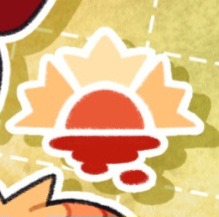
Ren's cutie mark is of a sunrise and looks pretty simple at first glance but there was a lot of thought that went into this one.
First of all, I bet you're wondering why a sunrise? Well, in the show, it is pretty typical for unicorns with great magical abilities to have one relating to space (examples being Twilight Sparkle, Sunset Shimmer, Starlight Glimmer, and Sunburst). And I figured since I wanted Ren to fall into a similar position of potentially becoming an alicorn, I gave him a cutie mark following the same trend. And I chose a sunrise to reflect the way Ren seems to glow when he enters a room. The way he carries himself is very warm and bright it just catches your eye in a similar way the sun would.
Also, Ren wears sunglasses. So a sun-themed cutie mark seemed appropriate.
Additionally, there are a couple of smaller details I want to point out too. Like the sun rays, if you look at them for a moment you'll see they're shaped like little crowns! I of course had to put a crown in thanks to how much Ren likes to play royalty, so I snuck it in there. And then the red spots underneath could both be interpreted as the sun reflected over water or blood. (But of course, this is a kid show AU so there wouldn't be any blood in Ren's destiny, just a fun reference to the red king and his whole thing about blood dyeing the snow red)
Martyn's Cutie Mark
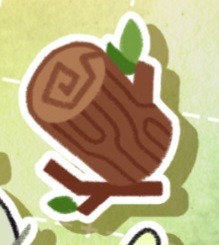
I explained this one in an earlier ask but I thought I'd explain it again here for anyone who didn't see it!
Martyn's cutie mark is of a chopped log and a small stick.
This one is mostly a play on the name "Littlewood" but has other meanings too. As a character, Martyn tends to travel and explore quite a bit. In the Life Series specifically, he is usually the last one to find a permanent base and even then doesn't spend a lot of time in one place. Always on the move. Additionally, he's more of a wild card compared to other characters, always trying to be as unpredictable as possible.
The smaller detail here is the little swirl on top of the log is the same as the one on his Minecraft skin's shirt.
BigB's Cutie Mark

Cookies! Cookies! Cookies! BigB's cutie mark is of 3 cookies where one is trying to eat the others. There are also a few sprinkles there made to look like action lines.
We all know BigB loves cookies so of course I had to give him a cutie mark with cookies in it. For this one, I decided to follow the cutie mark trend of "symbol/item important to the pony duplicated 3 times" (examples being Fluttershy, Applejack, Rarity, Pinkie Pie) but I added a bit more creativity to it with the top on trying to eat the others to represent just how tasty they are 😋
Additionally, rather than the first cookie trying to eat the others, you could interpret it as opening its mouth to talk. Because BigB can not keep a secret to save his life! In Double Life when he started "secret soulmates" with Grian, he didn't last a day without opening his mouth. He told Ren about it immediately because he felt bad for keeping things from him.
Also worth quickly mentioning: People pointed out in my original post that they don't think BigB would be the element of honesty because of his behaviour in Secret Life. But that's just Secret Life. I think Secret Life to BigB was like that episode of My Little Pony where Discord makes the main 6 act the opposite of their true element. BigB was just going through a weird phase of telling very obvious lies because a book told him to.
Skizz's Cutie Mark
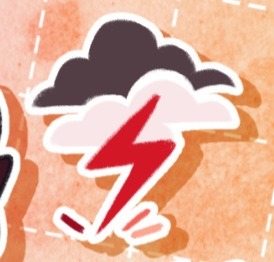
Skizz's cutie mark is of a lightning bolt from a couple storm clouds hitting the ground.
I think this is the cutie mark with the least thought put into it, unfortunately. There was still though just not as much as the others. The big thing I thought was fun was I made the lightning bolt shaped like an "S" to stand for Skizzleman. But other than that, this cutie mark sort of has the same meaning as Rainbow Dash's cutie mark. Quick like lightning, loud, bold, dangerous, and powerful.
Impulse's Cutie Mark
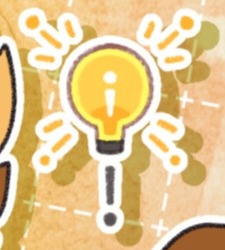
Impulse's cutie mark is of a lit-up lightbulb.
I absolutely crowded this cutie mark with the letter i. If you look closely, there are 6 of them. Impulse's design also has an i-shaped pattern on the belly if you look closely enough. But that's more of a fun easter egg and doesn't exactly reflect Impulse as a character.
There are a couple of reasons I chose a lightbulb for Impulse, the first and probably most obvious is that he's a redstone guy! He's a technical guy who likes to work smarter, not harder. So I figured the My Little Pony equivalent would be a light bulb/electricity. The second reason for the lightbulb is that it's usually used as a visual representation when characters have that "eureka!" moment in cartoons. When someone has a brilliant idea a little lightbulb turns on above their head. So since Impulse is the ideas guy, I figured a lightbulb would work for his cutie mark.
Etho's Cutie Mark
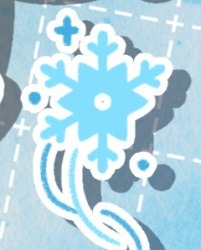
Etho's cutie mark is of a snowflake with a missing branch.
I promise there is more to this cutie mark than just "Canada is cold" even if that's part of the reason I wanted to give him a winter-themed cutie mark. While it is fun to make a nod to Etho being Canadian, I thought a winter-themed cutie mark would be fun to represent how he sometimes presents himself. Cold and a bit mysterious. I think deep down once you get to know him, those attributes melt away, but for people who have never met him, he may be intimidating that way.
I'll be honest, I don't watch a lot of Etho content, but I do have a few friends who identify as Etho girlies so I did my research. I was told in his Minecraft Let's Play World, that he has a snowflake build somewhere. I believe they said it was an iron golem farm? (Please correct me if I'm wrong) but I thought that was perfect for the cutie mark. And if you're wondering why there's a branch missing, it's because one of my friends said he was incapable of finishing builds sometimes so I thought that would be fun to include.
-=+=-
Alright. Rant over. To celebrate, here are a few pony doodles so I can put this post in my art tag.
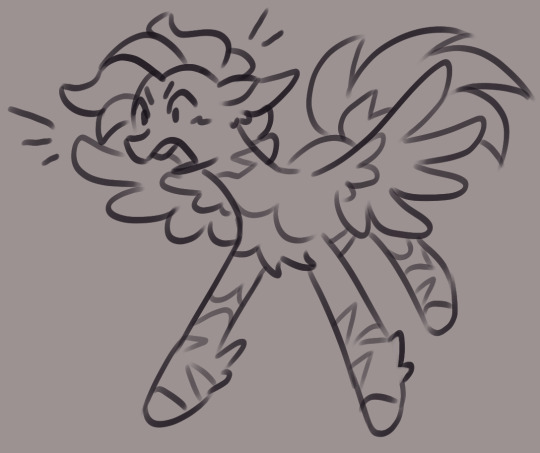
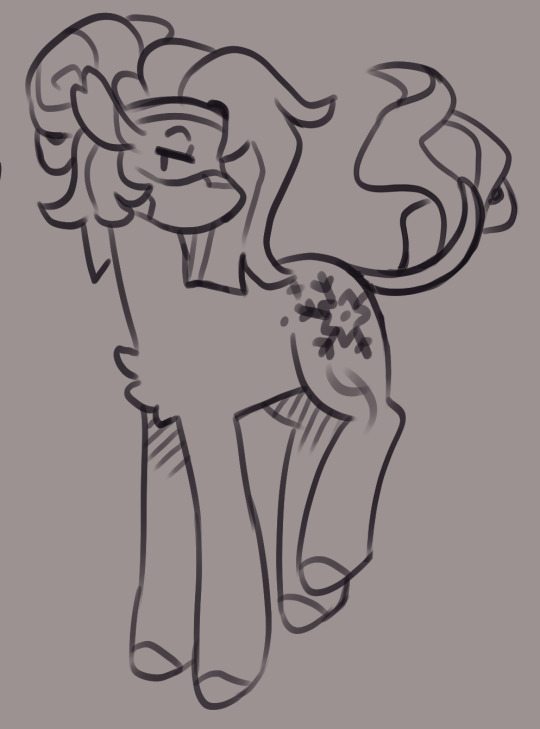
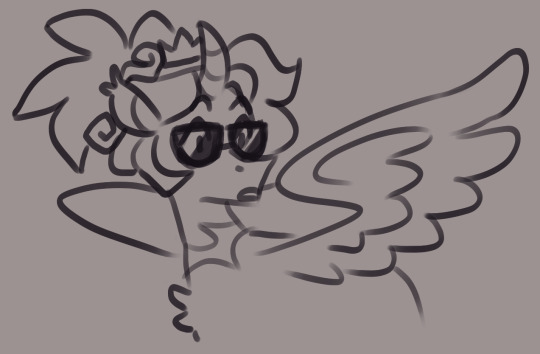
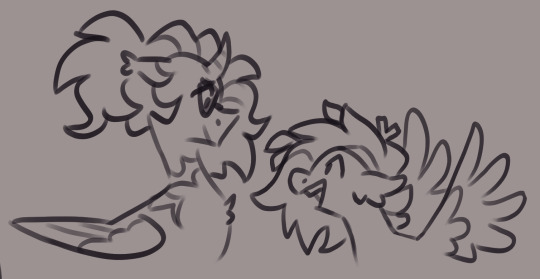
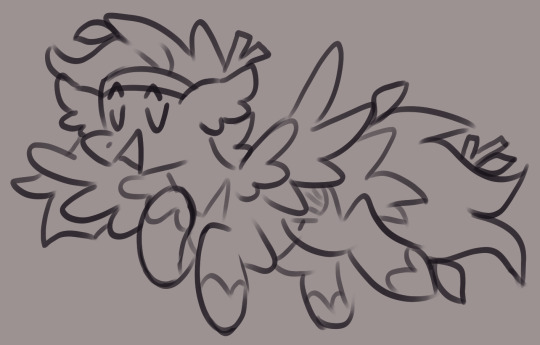
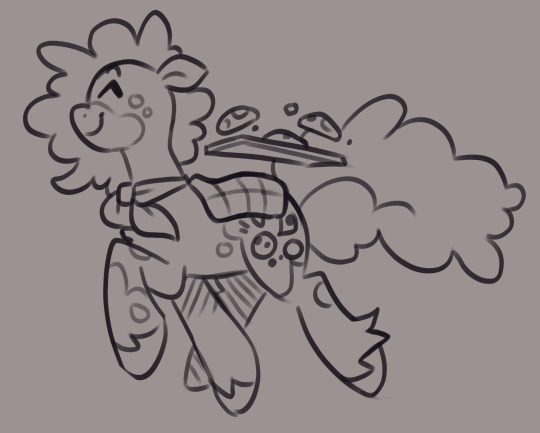
#cherri.speaks#cherri.draws#trafficblr#my little pony au#renthedog#inthelittlewood#bigbst4tz2#skizzleman#impulsesv#ethoslab#Third Life x MLP#mclp
739 notes
·
View notes
Text
A dumb hypothetical that I think about way too often is the "1 of every Pokémon VS a billion lions" one, because to formulate an answer to this question requires answering a bunch of subquestions to work out just how strong/effective a small handful of Pokémon actually would be in this scenario. Because while there are a lot of Pokémon who could fight a bunch of lions and win, a billion lions is in fact quite a lot of lions, to the point where we struggle to fully grasp the number. Even some of the strongest Pokémon who could arguably take down 100's of lions could still barely make a dent in a billion.
But the subquestions I mentioned don't all apply to the strongest Pokémon (a bunch still do though), but instead to a bunch of specific Pokémon who could be extremely effective in this specific scenario. I will now present some examples:
1. Do the Lions have any way of harming Shedinja?
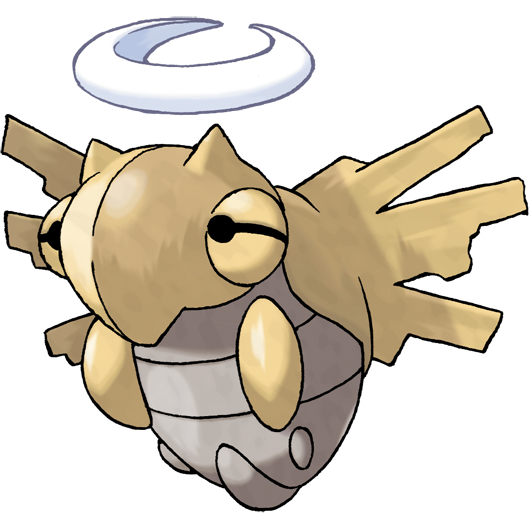
Shedinja may be a posessed cicada shell with a whopping 1 HP, but it also has the ability wonder guard, which means that only attacks that are super effective can hit it. Lions don't use Pokémon moves, this is because they are lions. Shedinja doesn't need to eat or drink either, it just floats ominously. Therefore, unlike the lions it won't eventually die of hunger or thirst. Are the Lions even capeable of hurting it? And to expand upon this, are they capeable of harming any Ghost type Pokémon? If not, easy Pokémon victory.
2: What about Pokémon that are too hot to touch?
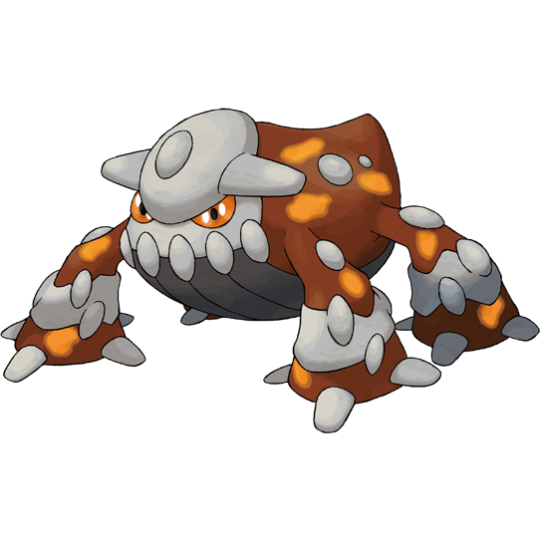
Firstly, I'm not talking about the whole "The Pokémon Sapphire Pokédex says Magcargo is hotter than the sun" thing, because we know for a fact that simply isn't true. However, that doesn't change the fact that there are Pokémon that are at least partially made out of lava/magma (does how you describe their biology depend on where they physically are at the time?). Just like us, stuff that hot is something the lions would want to avoid. How could they defeat these Pokémon?
3: "To protect its Trainer, it will expend all its psychic power to create a small black hole."
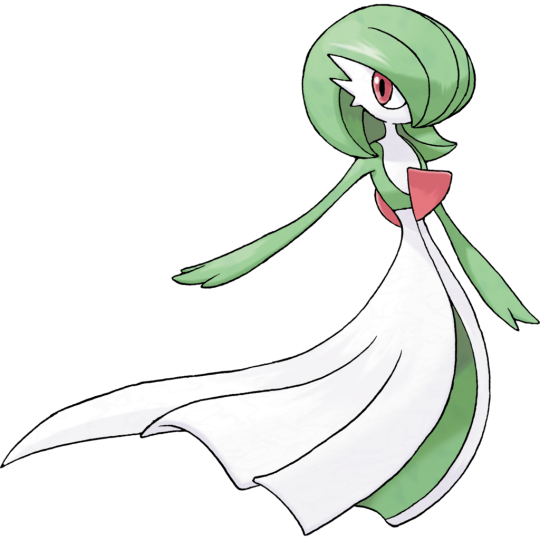
Ok, to quickly state the obvious: The Pokédex is pretty far from being a reputable peer reviewed journal. But it is also our best source of info on what Pokémon are capeable of, and it repeatedly states that Gardevoir can create "a small black hole". What a "small black hole" means exactly is honestly really unclear. Is it an actual black hole? If it is than Gardevoir could singlehandedly make a huge dent in the number of Lions.
4: Adjusting the Weather Forcast
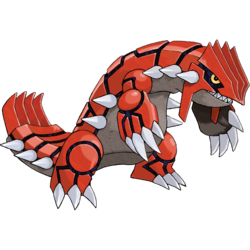

So, flooding the entire planet would defeat the lions, and so would a permanent drought. These two are both capeable of causing one of those things each. But both really want to do their thing, and really don't want the other to do their thing. Could they come to a peaceful agreement in the face of a common enemy (the lions), or would they continue to fight? Also, would they even have time to complete their weather based win conditions? Kyogre's would work faster, but flooding the entire planet would take quite a lot of time…
5: The big one, what is usually the ultimate argument in favour of the Pokémon. Is Arceus actually God?
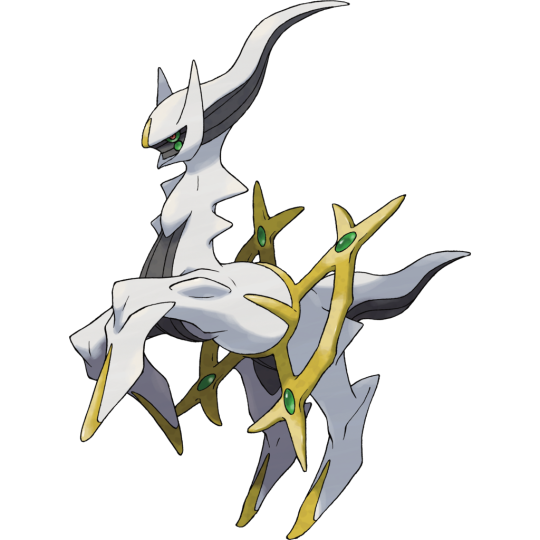
If Arceus is God, than instant undeniable dub for Pokémon with 0 questions asked. But, there's an issue with Arceus's divinity that many people aren't aware of. Arceus has claimed that it is God and that it created a bunch of the other legendary Pokémon, and the Pokédex corroborates this. BUT! The truth of this myth relies upon Arceus being the first Pokémon. This is where Arceus comes into question, because we already had a first Pokémon:
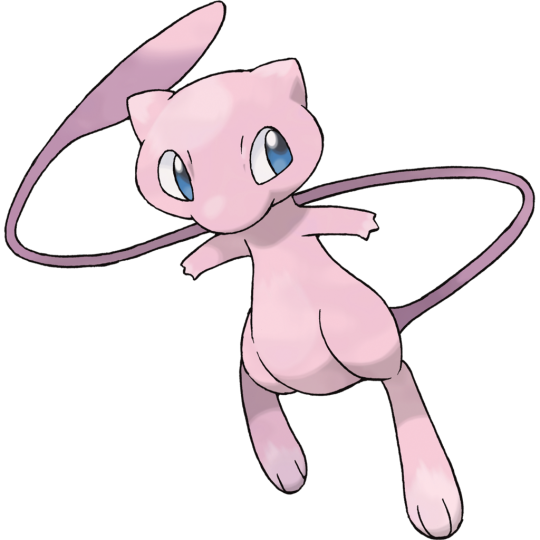
Mew, who has been in the series since gen 1, and who is theorised (in universe) to be the common ancestor of all Pokémon. Mew was therefore the first species of Pokémon, from which all other Pokémon are descended. But then how is Arceus also the first Pokémon? The question of whether Arceus is God or just an absurdily powerful Godlike Pokémon depends on whether you adhere to Pokémon creationism or Pokémon evolutionary theory. Basically though, there's a chance that Arceus may not actually be God, which changes things quite substantially.
Some less important questions that still Kinda matter (a little):
Just how hard is Registeel? It's hollow, but made of "a material that is harder than any known metal" (quote from Bulbapedia) could the Lions deal with that?

Yveltal steals the lifeforce of living things around it, Could it slurp up a billion Lions?
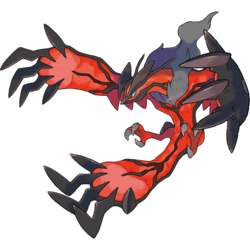
How many Lions could Guzzlord eat?

403 notes
·
View notes
Text
in re: “cas knows dean better than sam”
“cas sees dean as a whole person and sam just sees dean’s façade as his big brother slash parent” but like how and where. outside of your fanfiction. season and episode. scene and line. if it’s so obvious and apparent you should have at least 3-5 concrete examples right? “sam doesn’t know dean carried him out of the burning house” yeah but did cas? outside of a footnote in the angelic manila folder they gave him between seasons 3 and 4 so he could better manipulate him and sam into doing heaven’s bidding? like if you’re going to say “cas knows dean better than sam” than you need to show how cas succeeds where you perceive sam to be failing at the very least. but even your perceptions of how sam doesn’t measure up are so warped, blinkered, and moronic that it wouldn’t even be worth much if you could provide the textual evidence, but at least you’d have a semblance of a point. like say anything without going “as an eldest daughter…” “well my relationship with my sibling isn’t…” please say anything without fucking projecting your own self-pitying crybaby bullshit onto your little woobie dean and using the actual canon text of the show. I’m literally begging you.
like the thing of it all is and always has been that you’re so hell-bent on twisting the sam and dean relationship to fit into this narrow and almost entirely inaccurate mold which is the basis upon which you build the entire Destiel Mythos that you literally lose all sense of media literacy. you don’t even miss the forest for the trees, you miss the trees for like, the pretend invisible things you’re seeing in between the trees, the forest is a whole long way away from your current level of perception. because the Destiel Mythos is based entirely on the fact that dean is Not Seen and Not Appreciated and Not Loved and Cannot Be Himself until cas comes along, and that Family (read: sam) Is Only A Burden on Him That He Must Be Freed From In Order to Flourish, so you keep trying to warp the sam relationship into something that is only one dimension of it – and keep ignoring the ways in which dean is seen, loved and understood within it, because you need to keep lying to yourselves that there is a narrative need to emancipate dean from something that he has never wanted emancipation from because it is ultimately a net good for dean in the particular circumstances of their lives. it’s also profoundly unhealthy, codependent, evil and toxic etc. (a lot more dean’s fault than sam’s but I will nawt be getting into all that right now) but that doesn’t change the fact that sam and dean both know and understand and feel deeply that they are each other’s person – that they know the best and love the most in the world. but that – which IS true canon fact – is incompatible with the Destiel Mythos so it must be ignored and all good sense must be thrown out the window in order to do it.
anyway i digress there are two main categories of Bad Thinking that i will be addressing below
childhood/ “parent/child” / blah blah blah
every single thing people are saying in favour of the deeply stupid thesis in the title of this post is proof positive of the very silly form of ‘analysis’ I just described. a few things:
“wah sam didn’t know that dean carried him out of the burning house :( this means that dean withholds things from sam to protect him because he is a PARENT and sam can only know things about him in the context of him being a PARENT to him” – what the fuck are you on about genuinely. first of all reducing the sam/dean relationship exclusively to parent/child is in itself foolishness for so many reasons that I don’t have time for right now. but also, it’s clear that this is just something that happened when sam was a baby that just never came up. in the scene (1.09) where this is brought up, dean is mildly surprised that he or john never mentioned that detail and then states that sam knows the rest of the story (i.e. the actual traumatic stuff) just as well as dean does – which is true, demonstrably whenever they talk about it.
obviously there are some things that happened to dean in their childhood that sam doesn’t know about (or didn’t know about, until told in whatever episode they come up in). equally, there are things dean doesn’t know about sam’s childhood, e.g. the fact that he was so lonely he needed a zanna (11.08). or how dean didn’t remember that sam was friends with barry cook until he mentions it when they go back to their old school (4.13). or about the nature of sam’s relationship with amy pond (7.03). these don’t mean that ‘sam withheld these things to protect dean out of parental love’ lol, it’s just that there are details and events in each of their lives that the other happens to not have been told about.
similarly “sam didn’t even know dean wanted to be a firefighter L” girl did dean know sam wanted to be a lawyer? in 1.01 he’s pretty surprised that sam has a law school interview. the point here isn’t “neither sam nor dean know each other well,” these are minutiae that aren’t relevant to how well you know someone as a whole, and very poorly demonstrate the bad and inaccurate point that dean withholds things from sam the way a parent does a child (on a constant or regular basis). obviously the way they were raised, sam was deemed too young to know about certain things until he got older and dean had to keep that secret, but as shown in 3.08 flashbacks, most if not all of this is eventually revealed throughout their childhood when sam is still fairly young.
or possibly the dumbest one is that “wah sam doesn’t even know that dean reads books L” whenever that was he was also obviously joking because in more serious moments (e.g. 8.14) he admits that dean is smart/a better researcher than he is, literally remembers dean reading to him as a kid (8.21) so like. clam down
one of the extra annoying variants of this type of ‘proof’ covers things that are very clearly novel pieces of information about dean that dean, sam, and the audience are learning about dean in real time. like if you’re actually watching the show to comprehend it as it was intended to be comprehended, instead of funnelling everything through the Destiel Machine until it’s unrecognizable slop that fits neatly into your pre-ordained molds that Make Destiel Necessary In the Narrative (when it actually isn’t, at all) it’s abundantly clear. the top two worst offenders:
“sam didn’t even know that dean is good with kids :( he doesn’t even realize that dean raised him :(” first of all you people need to understand that parentification does not literally create a parent-child dynamic between siblings but I digress – this doesn’t make any sense bro. in 1.03 dean admits he doesn’t know any kids as an adult. dean being good with his own kid brother when they were both kids is to any reasonable person not necessarily linked with him being good with other random kids when he’s an adult. in 1.03 it’s clear that dean himself is a bit surprised that he’s able to connect w/ lucas so well because he’s clearly not dealt with a lot of kids since sam grew up. the whole point of this is that dean, sam, and the audience are all sort of seeing a new side of dean. who again is just 26. after this very early episode, there’s no question from sam that dean is able to connect w kids. sam being a bit surprised by this also has absolutely zero connection with him not understanding or realizing that dean looked out for him when they were both kids – sam is standing there at 22 years of age talking about adult dean and children – of fucking course he doesn’t mean himself are you stupid.
from the very first season, sam is very clearly aware of everything dean ~did for him~ when they were kids, see e.g. 1.21: “Dean...ah...I wanna thank you. […] For everything. You've always had my back you know? Even when I couldn't count on anyone I could always count on you. And I don't know, I just wanted to let you know, just in case.”
and 1.06: DEAN: Well, I’m a freak, too. I’m right there with ya, all the way. (SAM laughs.) SAM: Yeah, I know you are.
and then possibly even more stupidly, the one where it’s like “wah sam doesn’t even know dean can cook :( he doesn’t even know that DEAN was the one making him food as a babe in arms :(” – when sam is surprised that dean made something fairly gourmet and from scratch literally the first time they have ever had a permanent living space with a functional kitchen. in this VERY scene (8.14), dean himself points out that they haven’t had a kitchen before and when sam remarks on the irregularity of him doing serious cooking, he says “I’m nesting”, clearly showing that this is a novel development because they now have a kitchen, and that it’s irregular relative to past behaviour – both of them acknowledge this. because real proper in-depth cooking and making box mac and cheese for sam until he was like 11 and old enough to be left alone are two different things, which sam understands because he’s smart, unlike whoever chooses to make this point. dean never showed significant signs of liking to cook before this, which is what the exchange is about, but he did have to prepare food for them both when sam was too young – of course sam knows he had to, there are childhood memories referred to (e.g. 14.11) where sam is mentioned to literally help dean do the cooking as kids lol (and yes, genius, sam says ‘I didn’t know you knew what a kitchen was’ or something to that effect, but if you think he’s being 100% literal there I have an oceanfront property in Kansas to sell you)
again, obviously there are pieces that sam doesn’t know about dean, e.g. when he’s talking about his response to mary dying in 1.03. but again, Sam is 22, dean is 26, the last time they were in regular contact was when sam was 18-20, these are things that happen when people grow up, they’re able to reflect and share on childhood experiences if they’re close with their siblings as adults. it’s clearly not something that 26 y/o dean wanted to hide from 22 y/o sam. yes sam didn’t know everything about how dean felt when they were young, but that’s equally true in the other direction, and it’s such an irrelevant point in this discussion when, crucially, sam does learn these things about dean mostly fairly early on in the series (i.e. when they’re really not that deep into adulthood yet). cas was also not magically blessed w/ knowledge about dean, he also had to learn whatever it is that he knows, but somehow sam has to know everything about dean from age 7 or it doesn’t count when it’s sam lol.
“sam doesn’t know the One True Dean / doesn’t see through his facades”
the next branch of defending this flawed thesis is invariably that sam has little idea of the fronts and facades that dean puts up and is content to just believe them, whereas cas digs deep and sees the One True Dean that stupid sam always misses. there is nothing in the text that demonstrates this is true. multiple times, we see sam being very knowing of the fact that dean puts up fronts and facades. sam is also knowledgeable of the way dean perceives himself, and – demonstrated in multiple episodes before such sam lines were very poorly recycled and regurgitated into cas’s dialogue in 15.18, but keep acting like that was the first time anyone ever showed that they knew the One True Dean.
Obviously there are times where sam teases dean when he’s being more touchy-feely than usual, but 9.99 times out of 10 (as a conservative estimate in case there's something i'm forgetting otherwise i would say every time) that’s very clearly coming from a place of knowing the real dean vs. the façade he puts up because that’s the whole joke. and it’s allowed to be a joke because they’re siblings and that’s what siblings do lol. esp since sam and dean have touchy feely moments at the end of like every episode.
examples of all of the above off the top of my head (there are more than these, but these are the ones I can think of):
2.02 (about John’s death)
Sam: “I mean this ‘strong silent’ thing of yours, it's crap. […] I'm over it. This isn't just anyone we're talking about, this is Dad. I know how you felt about the man.”
Dean: “You know what, back off, all right? Just because I'm not caring and sharing like you want me to.”
Sam: “No, no, no, that's not what this is about, Dean. I don't care how you deal with this. But you have to deal with it, man. Listen, I'm your brother, all right? I just want to make sure you're okay.”
2.03 (Sam to Dean, also about John’s death): “You know, you slap on this big fake smile but I can see right through it. Because I know how you feel, Dean. Dad's dead. And he left a hole, and it hurts so bad you can't take it, but you can't just fill up that hole with whoever you want to. It's an insult to his memory.”
Note that Dean essentially admits that Sam is right in these two instances in 2.04 bc I know yall have stupid shit to say about john too that has nothing to do with how anyone actually felt about him in canon
3.07 (about Dean’s demon deal – also proven true in later episodes)
SAM: Dude, drop the attitude, Dean. Quit turning everything into a punch line. And you know something else? Stop trying to act like you're not afraid.
DEAN: I'm not!
SAM: You're lying. And you may as well drop it 'cause I can see right through you.
DEAN: You got no idea what you're talking about.
SAM: Yeah, I do. You're scared, Dean. You're scared because your year is running out, and you're still going to Hell, and you're freaked.
DEAN: And how do you know that?
SAM: Because I know you! […] Yeah, I've been following you around my entire life! I mean, I've been looking up to you since I was four, Dean. Studying you, trying to be just like my big brother. So yeah, I know you. Better than anyone else in the entire world. And this is exactly how you act when you're terrified. And, I mean, I can't blame you. It's just […] I wish you would drop the show and be my brother again. 'Cause... (can't find words; tears in his eyes) just 'cause.
5.18 [Sam figures out what Dean is doing re: his plan to let Michael possess him, tracks him down, and eventually is the catalyst for Dean ‘making the right call’, which he predicts] – e.g.:
SAM: No, you won’t. When push shoves, you’ll make the right call
DEAN: You know, if tables were turned…I’d let you rot in here. Hell, I have let you rot in here.
SAM: Yeah, well…I guess I’m not that smart.
DEAN: I—I don’t get it. Sam, why are you doing this?
SAM: Because… you’re still my big brother.
8.14 (basically the o.g. version of whatever went on in 15.18 + sam intrinsically understanding the trials are a death wish for dean): “I'm closing the gates. It's a suicide mission for you. I want to slam hell shut, too, okay? But I want to survive it. I want to live, and so should you. You have friends up here, family. I mean, hell, you even got your own room now. You were right, okay? I see light at the end of this tunnel. And I'm sorry you don't – I am. But it's there. And if you come with me, I can take you to it. […] I AM smart, and so are you. You're not a grunt, Dean. You're a genius – when it comes to lore, to – you're the best damn hunter I have ever seen – better than me, better than dad. I believe in you, Dean. So, please – please believe in me, too.”
10.22 (understanding how much dean has ~done for him~)
SAM: I'm saving my brother.
CASTIEL: You told Dean—
SAM: —I know what I told Dean. Cas, look. I've been the one out there, messed up and scared. And alone. And Dean—
CASTIEL: He did whatever he could to save you.
SAM: Yes. I mean, it's become his thing. I owe him this. I owe him everything.
10.23 (basically the o.g. version of whatever went on in 15.18, x2 – from Sam to Dean): “You were also willing to summon death to make sure you could never do any more harm. You summoned me because you knew I would do anything to protect you. That's not evil, Dean. That's not an evil man. That is a good man crying to be heard, searching for... some other way. […] You will never, ever hear me say that you -- the real you -- is anything but good.”
11.13 (Sam understanding exactly how Dean feels about Amara being his ‘deepest desire’, and confirming that it doesn’t make him a bad person)
Dean: Why? Because if she is that means that I’m…
Sam: Means you’re what? Complicit? Weak? Evil?
Dean: For starters, yeah.
Sam: Dean. Do you honestly think you ever had a choice in the matter? She’s the sister of God, and for some reason she picked you and that sucks, but if you think I’m gonna blame you or judge you…I’m not.
Dean: You know that I want her ass dead.
Sam: Yes. Of course. And I know you’ve also probably beaten yourself up a hundred times over it, but where has that gotten us? (Long silence) Just how bad is it?
13.02 (Sam perfectly explaining Dean’s psyche to Jack)
JACK: Is that why Dean hates me?
SAM: Dean doesn’t hate you. It… Look, sometimes the wires in Dean’s head get crossed and—and he gets frustrated, and then he mixes frustration with anger, and—and fear.
JACK: Why would he be afraid?
SAM: Because Dean feels like it’s his job to protect everyone. And right now, we need to protect you. But we may also need to protect people from you.
14.03 [Sam assesses Dean’s psychological/emotional response to the Michael possession; end of episode, Dean confirms that Sam’s assessment was fully accurate]
14.10 [Sam is the only one able to snap Dean out of his weird Michael mind loop by using their code word]
14.11 [Sam figuring out that something is troubling Dean just based on the fact that Dean hugs him]
15.17 (self explanatory at this point)
DEAN: Chuck has to die. He has to! Otherwise he'll keep us tap dancing forever, and I can't live like that, man! I can't live like that! I won't!
SAM: I know you feel like that right now, okay. I know you do. But you gotta trust me. My entire life, you've protected me— from Dad, from Lucifer, from everything. I didn't always like it, you know, but... it's the one thing in the whole world that I could always count on. It's the only thing I've ever known that was true. So please... put the gun away. Just put it away, and we'll figure it out, Dean, we'll find another way, you and me. We always do.
like maybe there are some cas moments w dean along these lines too. i don't know, i don't remember what the guy says or does anymore it's been too many years and he is not memorable. but the point is where and in what capacity and based on what metric other than the amount of bad fanfic you've read does cas exceed sam in these respects.
so basically just. genuinely, what are you people literally ever talking about. go watch the show instead of saying stupid wrong stuff about sam on the hellsites all day. or watch another show (please for the love of god watch any other show this one is absolutely lost on you and it’s such a stupid one too i'm embarrassed for you)
#sorry i wasnt gonna be able to sleep otherwise my blood pressure got too high#sam winchester meta#sam winchester#anti destiel#sam and dean#whatever else my tags are#haven't done this in a minute#i'm sorry for being a cunty sam stan (tm) in this but have you considered we'd be nicer if you ppl were less dumb#this is not proofread it's not real meta
491 notes
·
View notes
Text
🕯Mercury in Astrology


Information is from Chris Brennan's video on The Astrology Podcast YouTube channel on the topic of Mercury significations <3
Mercury: writing, speech, words, message, reign, translation, conveying, transmitting, information, interpretations, numbers, analysis, reasoning, details, dialogue, exchange, money, businesses, contracts, commerce, negotiating, indecision, disputation, questioning, doubts, distractions, speed, variety, irregularity, verstatility, changing, adaptability, flexibility, instability, inconsistency, knowledge, philosophy, service, teaching, mind, intelligence, intellect, language, communication, learning, poetry, voice acting, narration, acting, sharing, masculine, neutrality
Sun and Mercury:
Sun and Mercury are both centered around intelligence but in different ways; they complete each other. Sun is about divine knowledge and Mercury is about conveying, transmitting or communicating that knowledge or even perhaps analyzing it and extracting more wisdom as well as detail from it so I found this point particularly interesting. Sun illuminates with its rays and gives clarity by providing us with the truth and then Mercury expands on that truth and shares it with others in its charming versatile way as well
Sun vs Mercury sign:
Mercury does not move further than 28 degrees from the Sun meaning that the Mercury sign will always be the sign before or after the Sun sign (zodiacal signs are divided into 30 degrees) and so there is a bit of a differentiation (for lack of a better word) between who we are and the way we communicate and exchange information with other people if the Mercury and Sun signs are not one of the same. First example that comes to mind is having an Aries Sun Taurus Mercury and two people who are quite close to me have these placements; you would not know they were Aries Suns unless u asked hahaha even though one of them is an Aries rising too so that is something I wanted to note as well. Another example would be Sagittarius sun with Scorpio Mercury adding a lot of intensity to the person's communication style as well (which is something I relate to as you will see later on)
Domicile and exaltation:
Sooo Mercury rules over Gemini and Virgo so those are its domicile signs, it is how Mercury can manifest itself most comfortably whilst embodying its true essence. And then Mercury has its exaltation in Virgo as well which is pretty unique might I say and this gives me the vibes of (this my own way of seeing it so take it with a grain of salt) Mercury being more constructive in the sign of Virgo versus in Gemini just because of this particular distinction
But speaking of these two signs I do think they embody their Mercurial energies quite differently and shoutout to my friend @saturnianoracle for giving me the key words to describe this. First of all they are both analytic but Virgo is more of a skeptic I feel while Gemini tends to have more of an open mind. Virgo wants to see the evidence behind certain things to determine the merit or validity, to a certain extent, of the topics at hand to then decides if it wants to invest energy into looking into it more. It is very grounded as well as organized. With Gemini there is a certain sense of childlike curiosity that takes hold of this sign making it want to explore deep topics and of course stimulate its mind; it dives in without thinking and is more disorganized, inconsistent and chaotic I would say, and it loves conversing about its findings as well. I saw a tiktok video ancient astrology based describing Virgo and Gemini as the most intuitive signs which was fascinating to be honest u can watch it here
Detriment and Fall:
Mercury has its detriment in Sagittarius/Pisces and its fall in the sign of Pisces as well and the interesting thing noted in the video I watched (mentioned at the start) is that Sagittarius and Pisces are ruled by Jupiter, the biggest planet ruling over expansion and abundance, and with Mercury being on the smaller side you can really see that distinction of the Mercurial signs really often looking at the detail of things and well in contrast the Jupiter signs seeing the bigger picture. Also Jupiter being a benefic and ruling over luck makes me think that having these two placements is honestly not so bad tbh
Mercury in first house:
Mercury has its planetary joy in the first house of the self, highlighting the utmost importance of the curious, inquisitive and messenger qualities of the planet. What is interesting is the neutrality of Mercury and how we can link that with its joy being in the 1st house; a house that can be above or below the horizon, so even in this regard it stays neutral and does not "pick a side" if that makes sense; "acting as a bridge between the upper and lower hemispheres of the chart, a bridge between the celestial and terrestial realms which are united in the degree of the ascendant".
Source for the planetery joy information is Hellenistic Astrology: The Study of Fate and Fortune by Chris Brennan
I have made a more detailed post on planetary joys so check it out <3
Neutrality:
Mercury is not seen as a benefic or a malefic; it is considered a neutral planet. Of course, its manifestation and expression can be positive, negative or stay neutral depending on a few factors, such as:
Being in its domicile (Gemini/Virgo) or its exaltation (Virgo) sign is gonna lead it to manifest in a more constructive/beneficial way
Being in its detriment (Sagittarius/Pisces) or its fall (Pisces) sign would generally lead it to manifest in a less constructive way
Aspecting a benefic planet (Jupiter/Venus) would lead Mercury in this instance to manifest in a more constructive way as it is said to adopt the traits of benefic planet it is associated with
Being in a benefic ruled sign; meaning a Jupiter ruled sign as mentioned beforehand (Sagittarius Mercury, Pisces Mercury) or a Venus ruled sign (Taurus Mercury, Libra Mercury) would manifest in the same manner mentioned above
Aspecting a malefic planet (Mars/Saturn) leads Mercury to take on the traits of that malefic planet as well
Being in a malefic ruled sign so either Mars ruled (Aries Mercury, Scorpio Mercury) or Saturn ruled (Capricorn Mercury, Aquarius Mercury) leads us to Mercury adapting to that malefic's traits again
Triplicity also matters and I will make a detailed post on it soon but for now all I can say is that having Mercury in an air sign (Gemini, Aquarius, or Libra) adds on to the "power" that the Mercury placement has within the chart and the support that it gives to the native; if we are dealing with a day chart then Mercury has moderate support in the air sign in question (Saturn being its triplicity lord), and if it is a night chart then it maintains a powerful position within the chart, being its own triplicity ruler. (Source for triplicity rulership intormation is Ancient Astrology: in Theory and Practice: A manual of Traditional Techniques, Volume One: Assessing Planetary Condition by Demetra George)
That is all!! I wanted to go into more detail tbh but time simply does not allow it these days as I have my internship going on as well but I hope this was informative haha
Thank you for reading <3
Masterlist
Paid readings open
#astrology#astro notes#astro community#astro observations#astro tumblr#astrology made easy#astrology basics#astrology tumblr#planetary joys#triplicity rulership#mercury#mercury in astrology#mercury in 1st house#ancient astrology#hellenistic astrology
175 notes
·
View notes
Text

Tsukasa and Rui are known collectively amongst their classmates as "Oddball 1-2 Finish" (in the JP, KR, and TW servers. The English localisation calls them "Weirdo Wombo Combo"). Due to this, they are frequently asociated with the numbers 1, 2 and any combination or variation of the two (12, 21, etc), both individually and as a duo.
In terms of cover songs, there's Telecaster B-Boy, where they sing the counting part at the beginning. Tsukasa says the number 1, and Rui says the number 2. Tsukasa is Oddball 1, and Rui is Oddball 2.
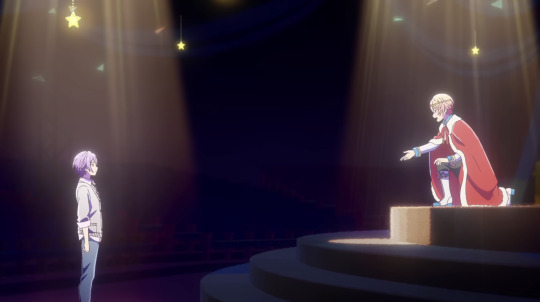
There's also a lyric in Oki ni Mesu mama sung by Tsukasa, that goes "Waiting for the "1, 2..." signal, holding hands with you is an act of courage for me". Whilst the lyric itself is entirely coincidental, having Tsukasa sing it was very likely intentional. The cover supposedly represents the growth in trust between Tsukasa and Rui, so with that context in mind, one could view the lyric as a reference to Tsukasa reaching out his hand to Rui at the end of the main story, a significant step in the development of their mutual trust.
There's also a few instances of staff releasing content for them on the 21st of a month. Examples include the Fixer 2DMV, which released on September 21st 2023, and their 2022 Summer Memorial illustration releasing on the 21st of August that year. This was also the 12th illustration in that series.
Coincidentally (or maybe not), A Story Where You Are the Star released on the 22nd of November 2023, or 11/22, and featured them both as 4* cards on the accompanying gacha. The event was announced the day prior, on the 21st again.
Rui's 3rd Anniversary Countdown illustration depicted their pillow fight from A Once-In-A-Lifetime Pandemonium!?, an event focused on their relationship, and was released 12 days before the anniversary.

The OST that plays during their Romeo and Juliet rehearsal in KAMIKOU FESTIVAL!, Ma・Ai no Theme ~True Love Song~, was later reused in A Song of Vows for You, Dressed in Pure White and released on the 2nd OST Album alongside the other music from that event. However, instead of being listed with the other tracks from that event on the album, it's listed as track 12.
Them being in class 3-C is a pun based on their status as Oddball 1-2. C is pronounced as "shi" in Japanese, which is the same as how the Japanese word for four is pronounced. Tsukasa and Rui being in class 3-C makes 1 2 3 4. Additionally, 1+2=3, and if you apply A=1, B-2, so on, then this also applies to A (Tsukasa's original class) + B (Rui's original class) =C.
There's also various smaller references, such as the full combo for KING on expert being 1002, Tsukasa growing 1cm and Rui growing 2cm at the 3rd anniversary, as well as Tsukasa telling Rui in the main story that he'll put 12000% into any role Rui gives him. The 12000% quote was also referenced in the 2DMV for their Dappou Rock cover.
#i'm playing colopale at their own game if they're gonna keep up the 1-2 references then i'll 1-up them#(i'm running this joke into the ground on my first go so i never have to make it again)#project sekai#tsukasa tenma#rui kamishiro
758 notes
·
View notes
Note
Hi there I have an arms question for you that I'm hoping you might be able to help me with. So it is commonly accepted that swords should not be kept in their scabbards long term, especially wood and leather ones as they absorb moisture and can end up trapping moisture on the blade and cause it to corrode. Which makes sense and is why most museums seem to try and store their swords out of the scabbard. My issue is I haven't been able to find any hard sources about if this is true or not. Whenever I try to find any sources I just find forum posts and nothing with research to back it up. Are you aware of any sources on the proper care and storage of historic swords?
Storing any carbon-steel blade - kitchen knife or antique sword - for a long time in a possibly damp container - drawer or scabbard - is not a good idea, and the kitchen knife is far more likely to be taken out for use and any incipient corrosion dealt with.
The sword is likely to just hang there, being admired from a distance, until one fine day it's brought down, drawn and OMG Look At The State Of It...!
But, am I aware of any (reliable) sources for care and storage of historic swords?
Unfortunately, no. :-<
*****
What I know is the care and maintenance of modern reproductions, so rather than give incorrect information which might potentially cause irreparable damage to some genuine artefact, I recommend that you send this same question to:
The Royal Armouries, Leeds, England ([email protected]).
The Wallace Collection, London, England ([email protected]).
The Metropolitan Museum of Art, New York, USA ([email protected]).
Conservation advice from any of those sources will be reliable and, based on past experience, they'll all respond.
*****
NB - I've seen "how to restore..." info on-line which is destructive to both historic and monetary value, and I can't shake the feeling that some - though not all, though THEY often require fully equipped workshops - YouTube channels deliberately create "aged items" which they then "restore".
*****
Japanese shirasaya ("white", i.e. undecorated) scabbards are used for storage and transport, though blades stored that way would certainly be inspected on a regular basis.

Blades in museums are frequently displayed "bare", with neither scabbard nor hilt furnishings, though that's as much to exhibit tang / blade inscriptions and hamon (edge pattern) detail as to avoid corrosion, like so:

AFAIK most "complete" swords alongside bare blades exhibited like this...

...are the blade's hilt and scabbard mounted on an insert to hold them together and show what the weapon looks like when fully assembled.
*****
A scabbard's function is threefold:
To carry the sword in a convenient manner.
To protect the blade from adverse conditions.
To prevent the blade from doing accidental harm.
Re-enactment back-carry scabbards which work by having big slots in one side or being hardly there at all ignore (2) and (3) in exclusive favour of (1). They never existed IRL.
*****
I've read a few articles by museum staff about conservation of old swords and when to stop - how much cleaning is enough, how much would be too much, preservation rather than removal of patina etc. - but nothing about the whys and wherefores of scabbard storage.
This may be because as history goes further back, original scabbards become much rarer than original swords, and often when a sword and scabbard ARE found together, they've corroded into one another to such an extent as to be inseparable.
This Etruscan bronze sword and its bronze scabbard are very unusual, not just two separate items but almost completely intact, with only the organic (horn or wooden) parts of the grip missing:

It helps that the Etruscan example is bronze, which doesn't degrade in the same way as iron or steel.
This iron or steel Iberian falcata shows the more usual fate - organic material like its hilt scales are gone, as is the wood and leather of its scabbard, leaving only metalwork behind. Despite that, the blade is in remarkably good condition.

Here's a repro showing how it would have looked when complete. A small utility knife mounted on the main scabbard wasn't unusual, and was also done in the late Middle Ages and Renaissance.

The same happened to this Roman gladius: its blade and scabbard frame remain, but the leather, wood and horn of the rest have vanished, taking most of the tang and deep bites of blade with them.

Again, a repro showing how it would have looked when new.

*****
However, sometimes scabbards survive.
This sword was found a few years ago (2020) in the Oder / Odra River in Poland, and though the grip - wood, probably bound with cord then covered in leather - has rotted away, its scabbard is in a remarkable state of preservation.

What the blade's like, and whether it will ever see the light of day without destroying the scabbard, is another matter entirely up to the museum staff dealing with it.

I suspect non-invasive methods such as X-rays or ultrasound will be used: intact period blades are (reasonably) common, intact period scabbards are not.

Scabbards for Important Swords owned by Important People, including - supposedly - saints are another thing, often far fancier than what originally went with the sword, and tend to be looked after appropriately...

...although a couple of these (centre and right below) have survived remarkably well despite just being entombed with their owners.

The non-metal parts of any working sword were, of necessity, replaceable.
If used in battle they would get stained, sticky and smelly. Over the passage of time they might get chipped, torn or broken. Or they might just be "great-grandad's old clunker", not thrown out yet but not maintained any more, because the style of swords has changed since his day so why bother?
Take a look at this drawing by Albrecht Dürer. That's a one-handed arming sword at least a century out of date and maybe two, while the state of the scabbard speaks for itself.

However though definitely not an elegant hand-and-a-half longsword as seen in other Dürer illustrations...


...that old clunker will still work as intended if sharp enough, and the tatty scabbard means bumping into its uncovered point will not be fun.
Been there, done that, Ouch!
*****
Storing / displaying swords out of their scabbards is sound, for the reasons you mention in your Ask.
However this recalls scabbard purpose (1) as listed near the top, since it exposes the bared metal to other risks such as humidity or inquisitive fingers, so some sort of coating is a good idea.
Oil or grease is messy and wipes off too easily, frequently on things better left without it such as clothing, cats etc., so try "Renaissance Wax" which I believe is used on original pieces by actual museums.
I've even read that it was developed by the British Museum though have no solid proof of that so YMMV, but I've been using it on my own repro swords for years, and can confirm that when properly applied (rub on, let dry, buff lightly with soft cloth) it adds a near-invisible layer of protection and does no harm.
*****
Hope This Helps!
*****
ETA (1) - Thanks to @librarianmouse and @pagecommando for reposting this with links to, respectively, the American Institute for Conservation and Forde Military Antiques Sword Cleaning Guide, links I've added here for completeness and my own convenience.
NB that the Forde Guide is very rightly peppered with warnings about what restoration can do to an antique, and that the swords it deals with are (mostly) mass-produced army-issue sidearms rather than one-of-a-kind weapons.
ETA (2) - @dduane asked "Why didn't you mention Blood Rust Guy?" I mentioned him very thoroughly Right Here. If you want an example of sword "care" not to follow, that's a good one.
104 notes
·
View notes
Text
Received a request for more information about personal pronouns! (Thank you very much to @/irafuwas for help with this post! ♡)
Personal Pronouns in Twst (1/3): Ore
Foreword: Pronouns can vary by person depending on age, gender and context, but they also vary based on personal preference and how a person wishes to present themselves! In casual situations there is not really such a thing as using the “wrong” personal pronoun. Outside of those situations it is all about being polite!
Q: Someone’s preferred personal pronoun can be interpreted as “rude” by unrelated third parties?
A: Yes! For example:

Ore: Used by Trey, Cater, Floyd, Ace, Kalim, Deuce (sometimes), Jamil, General Lilia, Leona, Silver, Ruggie, Jack, Epel (sometimes).
The vibes of pronouns change drastically depending upon whether or not you are in a casual situation:
School/Work/New People/Anywhere That Isn’t a Casual Situation with Close Friends
“Ore” is not a personal pronoun that one should use outside of very casual situations, such as when you are around friends or family, or it can be perceived as sounding haughty.

It can be described as a more “masculine” pronoun, but you can also say that it is just more casual!
Women can (and do!) use this pronoun and it does not mean that they identify as male—language is not black and white! It can even vary by region: the graph above shows how it is common for men and women equally to use “ore” in places like Akita, Iwate, Nara, etc., for example.

So does someone using “ore” with you mean that they’re looking down on you?
That depends on context!
If you are meeting for the first time, you do not want to use ore or you might put across that vibe. It is also rude to say it to people like teachers at school, bosses/customers at work, etc.
Casual Situations
If you are close friends or family members with a person, then it will not be unusual to hear “ore”!

Deuce, for example, uses “Boku” when he is around upperclassmen, but will use “Ore” when he is alone with Ace.
I prefer to avoid Wikipedia, but I liked this graph very much:

It shows percentages of university-age men using “ore” with their friends, switching to “watashi” in class, and to “boku” when speaking with someone they do not know.
(This information is, however, from nearly 20 years ago, and language is always evolving. Just like speakers of English do not talk the same now as they did in 2009, the same is true in Japan!)
It is not uncommon for men to decide they do not like the sound of “ore” and go with “boku” or “watashi” instead, or maybe they don’t like “boku” either and “watashi” is too formal for friends, so they go with “jibun,” etc. Casual situations are flexible!
Personal Anecdote: At my previous job I would often visit a senpai who worked the front desk downstairs, and he would rotate through three different pronouns depending who he was talking to: Watashi for customers, Boku for coworkers, and Ore for when his friends came to visit. And this was how I learned that he and our newest hire had started dating in secret: one day he accidentally used “Ore” with her instead of his usual “Boku.” After they realized that I knew, they would use casual pronouns/speech patterns with each other in front of me, but whenever someone else came in the room they would switch to senpai/kouhai speech. Drama drama~
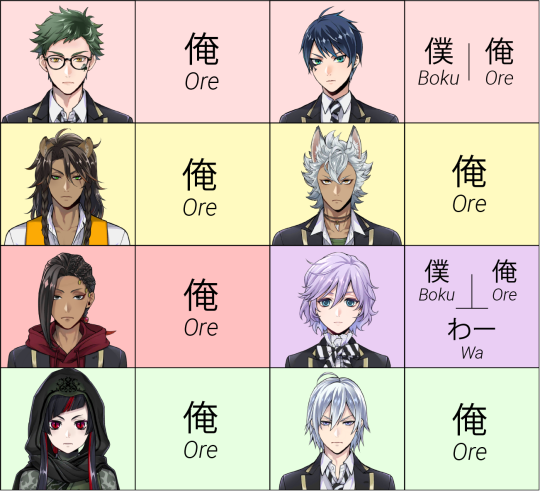

Written Language
In the case of Twst, we have additional personalization taking place: while Trey, Deuce, Epel, Jamil, General Lilia, Leona, Silver and Jack use “Ore” in kanji, Cater, Floyd, Ace, Kalim, and Ruggie use it in katakana.
This is a stylistic choice to reflect the different personalities!
Kanji can be used to make something seem more serious/mature/traditional (re: Trey/Jamil/Silver) or confident/assertive (re: Deuce/Epel/General Lilia/Leona/Jack).
Katakana is being used to add personal flair to reflect the characters who are more laid back and emphasize differences in attitude. Both Leona and Kalim say “Ore,” for example, and while it is technically the same word, the atmosphere/tone between the two could not be more different!
(To be continued!)
127 notes
·
View notes
Text
What is the Default Toa Form?
So, theory time.
It's a common fandom headcanon that the natural state of all Toa is the Toa Metru build. The reasons for this are varied (but if I'm honest seem mostly rooted in the fandom's love affair with the build that came to an end during the TTV Hagah Contest rather than any actual lore), but I personally disagree with this.
So I'm going to run through the various Toa builds in roughly chronological order (with one exception) and determine whether I think they're likely to be the true default form of a Toa.
1) Helryx
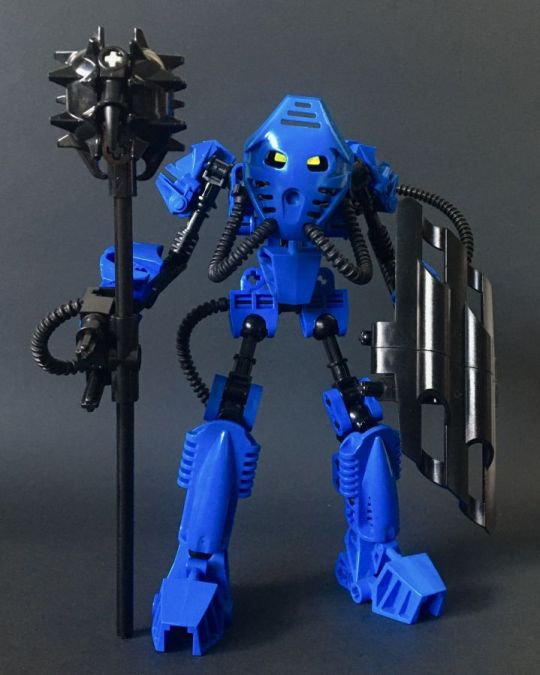
Well, right away, here's one that probably isn't.
Helryx is the oldest build lore-wise, newest IRL. She's also kind of a "Meta Build", aiming to look like a forerunner to the Toa Mata build we'll discuss shortly, not by directly evoking the way the Mata were styled (I would argue that a lot of the Mata's identifying hallmarks aren't present in her), but by being primarily composed of parts from 2001 and earlier.
However... this isn't what Helryx always looked like. Nor is the art that actually represents the canonised design.

The intent of the contest was to create Helryx as she appears in the present, after thousands of years of wear, tear and repair. In the text, she's referred to as disturbingly frail and alien-looking compared to what Takanuva expects a Toa to look like.
Even if she once looked like a default Toa, she doesn't now.
Orde, the only other known prototype Toa, never received a canon design (for what it's worth, I won't be putting a lot of weight on the DuckBricks Fanon Contest designs, since they're, well, fanon. So Bukkey's Orde won't be factored in here, besides me noting that he has a more Mata-esque body than Helryx does).
However, another popular headcanon is that Krakua represents another example of this generation of Toa, as Helryx would've been the basis for Krakua's transformation.

Perhaps this is what Helryx would've lookedd like when she was healthy and built?
Well, as much as I like that headcanon, and will continue to use it in fanon, probably not. Based on the evidence we have of Toa transformations, both in-story through Takanuva and the Toa Metru, the transformation is pretty much 1-to-1 with current forms. The Metru all get Lhikan's build exactly, except for specifically their height. Likewise, Takanuva's build is identical to Gali Nuva's, despite him not being a Toa Nuva. He didn't resemble base Gali, he resembled her current form.
If Krakua was transformed in Helryx's image, he'd likely be just as small, spindly, and hunched-over as she is.
For now, Krakua remains a weird outlier.
2) Mata
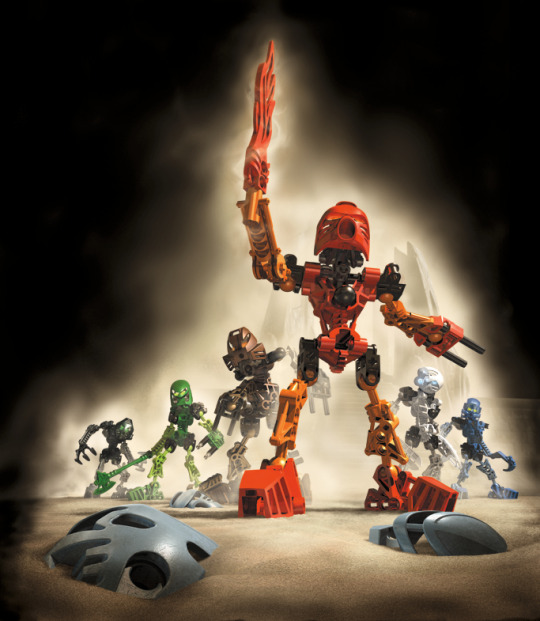
While not as common a choice as the Toa Metru build, the Mata build has also been suggested a few times as "Base Toa," largely because it's the original. It's relatively simple, and depicting any given Toa as a Mata build is easy enough and looks good.
(I honestly prefer it over the Metru build. It's easier to put proper hips, knees and elbows on a Mata than it is to un-fuck a Metru's shoulders and neck)
However, the Toa Mata are actually pretty much unique entities within the Matoran Universe, unlike any Toa before or after them. They are the only Toa who aren't transformed from Matoran or built by the Great Beings, instead being created by Artakha.
As a result of that unique method of creation, it's entirely reasonable to suggest that the Toa Mata look different to every other Toa in the world besides Takanuva, who was transformed in their image. They're the only canonical Toa whose bodies directly resemble the Great Spirit Robot itself, use these specific colour schemes, and have its specific design language in their construction.
3) Hagah/Mangai/Metru

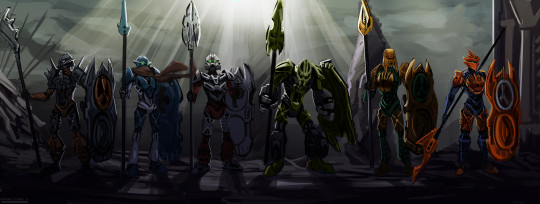

By far the most popular contender for this title, but one I don't personally agree with.
We don't know whether the Toa Hagah were built or transformed, but we know they were assembled from across the Matoran universe and given new armour upon recruitment into Teridax's team, and we have no idea what they looked like before they were given this armour, beyond Bomonga presumably already having his huge limbs. Additionally, the Metru were all transformed based on Lhikan, so it's him I'll be focusing on mostly.
Lhikan was transformed and was trained at a Toa Fortress around 6000 years ago. We don't know what the other Mangai looked like (though they're popularly headcanoned as being Metru too, no canon look for them was ever settled).
However, my stance is that this design is not the default (Lhikan would've been transformed in someone's image), but rather a cultural one, a sort of 'uniform' armour style adopted by Toa during the height of their power, when the Toa Fortresses were active and Toa were commonly trained by other Toa. The image of a Toa would've become a consistent thing, and caused almost all transformed Toa to adopt it for a time, making it almost a new default, but not the original, until the Toa genocide and the subspecies becoming largely extinct caused things to diverge again.
This is, to be specific, not a counter-theory I'm proposing to the "Default Metru" theory in and of itself, but rather a part of a wider theory, explaining the commonality of the Metru build when I think that the last spot on our list is the real default.
And that leaves us with only one option.
4) Inika/Mahri/Cordak/Nuva 2.0/Glatorian


So yes, I think this is the default Toa build.
That might strike you as weird, considering that the Inika are only transformed at the beginning of the Ignition Arc, right before the end of the story in terms of the MU's timescale, and the Nuva adopt this design even later.
But let's consider a few points, shall we?
First off, the Toa Inika are the first and only Toa team we see who are transformed into their Toa forms, and do not have their appearance influenced by previous Toa. And while there's some weirdness with their heads and powers, their bodies seem pretty normal, and remain as such after their Inika weirdness is removed by the Ignika.
Secondly, we know the Great Beings made the Matoran based on the Agori, and the Toa based on the Glatorian. The first Matoran, the default form of a Matoran as it were, are the Av-Matoran, who use the same build as the Agori exactly. Should it not stand to reason that a default Toa uses the same build as the Glatorian?
Additionally, like the Glatorian, the Inika build and its derivatives have by far the most variation from individual to individual. True, we've never seen a Toa as weird as Strakk, but that doesn't mean that none existed.
Thirdly, there's one more character we haven't discussed thus far.
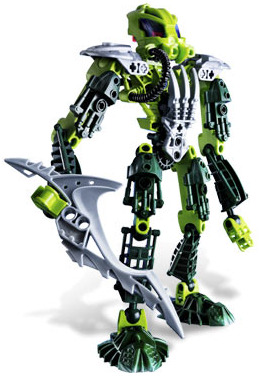
And this, then, is my smoking gun.
Lesovikk was a member of the first Toa Team, and one would assume based on that information that he's a purpose-built Toa. Well, he isn't. He's transformed. Given how rushed the Great Beings were at the end of the GSR project, I wager they found it easier to make a small number of Toa and then have them immediately transfer power to Matoran than it was to make thousands of Toa from the off.
Lesovikk may well be the first Toa transformed, and if he was, then his transformation would either be free of influence from anyone, or in the direct image of whomever transformed him, who could only be a default, purpose-built Toa.
"But wait!" I hear some of you typing already. "Lesovikk is a mutant, we have no idea what his true form looks like!"
Or do we?
Let's look at another character who was affected by Pit Mutagen in 2007, shall we?

This is Defilak, a Matoran of Mahri Nui. Like all the residents of Mahri Nui, he once lived on the Southern Continent, and later Voya Nui, after an ill-fated trip to Karzahni.
He used to be a weird little gremlin Matoran like his brethren from 2006, and transformed into the form above after being immersed in Pit Mutagen.
But here's the twist: Rather than simply mutating them directly from their twisted post-rebuild forms, the Mutagen actually reverted the Matoran of Mahri Nui to their original forms first, and only then started to mutate them.
This is Defilak's default form. This is what he always looked like, just with added weapons.
With that in mind, I think it's safe to say that Lesovikk is likely in the same boat: Reverted to his original form before the mutations started.
With the exception of the tube-like gill, I think it's more than probable that Lesovikk is mostly-normal still, and as such, is a very early Toa with a Mahri build.
With that in mind, I conclude that the default design for a Toa is a 2006-2009 build, with Helryx being the product of damage and repair, the Metru/Mangai/Hagah being a cultural design, the Mata being Artakha designs, and Krakua being a weird outlier.
#Bionicle#Toa#Toa Hagah#Toa Metru#Toa Helryx#Helryx#Toa Mangai#Toa Lhikan#Lhikan#Toa Mahri#Toa Inika#Toa Mata#Toa Nuva#Takanuva#Toa Takanuva#Lesovikk#Toa Lesovikk#Toa Cordak#Defilak#Krakua#Toa Krakua
147 notes
·
View notes
Text
What is Xenia?
Xenia is not just good manners. Xenia a test of character, and it's also a reflection of how the Greeks understood the relationship between humans and gods. Xenia was about more than offering food and shelter to travelers. It was a demonstration of how the gods governed human interactions and a reminder of the importance of hospitality as a virtue. The host was expected to offer protection, provisions, and shelter, often without asking the guest for any information or demanding any immediate return. The guest, in turn, was expected to be respectful, not to take advantage of the host's kindness, and to eventually offer something in return, though this could be more symbolic or reciprocal rather than transactional.
One of the key aspects of xenia was the idea that hosts could never know whether their guest might be a god in disguise. The gods were thought to frequently take on human forms to test mortals' hospitality. This divine oversight made it all the more important to treat every guest with respect, as any breach could bring dire consequences. This belief extended to travelers, strangers, and even those whose identities were unknown — showing hospitality was considered a moral obligation, an offering to the gods as much as to the human guest. While gifts were often involved, the true essence of xenia lay in the trust between the parties: the guest trusted the host to provide, and the host trusted the guest not to abuse their hospitality.
Violating xenia was one of the gravest offenses a person could commit. The punishment for such violations wasn’t just a matter of breaking a social norm; it was seen as a violation of divine order.
Xenia, in Homer's world, is a divine law.
The gods themselves are said to be the ultimate enforcers of xenia, so you'd better believe that disrespecting hospitality could get you in serious trouble. It's not just offering your guest a meal; it's offering protection, shelter, and a safe passage. If you don't uphold that, you're basically tempting the gods to mess with you, and they love doing that, trust me.
Remember when Telemachus first lands in Pylos? Nestor and his family treat him with the utmost respect, offering food, shelter, and stories (and Telemachus finds himself a boyfriend even LMFAOO). This hospitality isn't just a nice gesture; it's a social obligation that reinforces both the personal and communal ties within Greek society. Everyone's in this together, and they all have a part to play. Telemachus' growing appreciation for this custom reflects his coming-of-age journey, as he sees first-hand what it means to be both the host and the guest in the grand game of survival and honor.
For those who are yet to read the Odyssey, the scene basically goes like this:
“You’re the son of my old war buddy, Odysseus? Welcome! Come in, sit down, have food, have shelter, don’t ask questions- Here, my son is your age, share a bed with him :3 !!”
It's the perfect example of how xenia isn't just about being polite; it's about honor (excluding that last part lol). It's about building trust with someone you don't know based on a shared understanding that we're all part of this cosmic social contract. And Telemachus? He's learning that he's part of a much bigger world than just his little island. But he knew how to respect xenia even before he left Ithaca. We see this when he invites Mentor (Athena in disguise) into his home and offers him the munchies before even asking for the stranger's name. He's practically the golden boy of xenia.
And now let's talk about my favorite group of people — the suitors.
Honestly, they're just...the worst at xenia. Like, they didn't even try. Antinous? This guy is the poster child for everything you should NOT do in literally ALL of Ancient Greece. He straight-up mocks Odysseus, who's dressed as a beggar, by insulting him and telling him to leave, throwing a chair at him, and...shocker, he's the first to die. Who's surprised?
Xenia is a two-way street. It's not just what you get — it's what you give. You can't take all the food, drink all the wine, and then act like the host is just there for your enjoyment. You've got to offer something back. That's the whole point of xenia. And sure, you might not have gold and riches to give, but you can show gratitude. You can at least not insult the person whose house you're eating in.
Now, there's one suitor who stands out in the worst possible way, and I'm talking about Eurymachus. You know, this guy isn't just disrespectful, he's an outright traitor to Odysseus. Eurymachus was not just another arrogant man in Odysseus' hall; he was someone who, as a child, had been a guest in Odysseus' home. He was one of those who had been taken care of by Odysseus, fed and treated well. This relationship makes his betrayal all the more significant because it wasn't merely about a stranger dishonoring a host. It was about someone who should have known better, someone who had once been treated as part of the family, turning on Odysseus when the opportunity arose. Eurymachus' betrayal was far worse because it was not simply a violation of xenia; it was a betrayal of trust. He had been in Odysseus' house as a boy, and now he was trying to usurp everything Odysseus had built.
Then, of course, there's Amphinomus. The one suitor who has a tiny bit of decency. He's like, "Hey, maybe we shouldn't kill the beggar and the prince, maybe we should be decent human beings...Please??" And yet he's still part of the whole disgusting group. He doesn't even try to follow xenia; he just doesn't get as bad as the rest of them. So congrats, you're the “least bad” one. But that's like being the least offensive stain on a white shirt. You're still part of the mess. I still think he should have been spared and I would have kissed his cheek for it, but whatever.
The suitors were trash hosts because they didn't respect the rules of hospitality. They took, they didn't give back, and they thought they could get away with it because they were powerful. Well, guess what? No one's untouchable. Not even rich, entitled jerks like Antinous. There's a reason those guys met their end the way they did, and it's because they broke the most sacred rule in Greek society.
Because xenia is not just guarded by the gods, but by Zeus himself.
Zeus' disinterest in Odysseus' personal life is clear, but when it comes to the suitors? That's a whole different story. While he might not always be in Odysseus' corner, Zeus has no tolerance for anyone who dares to violate the divine laws of xenia — particularly when it involves the destruction of a sacred home. I will remind you, Odysseus was a KING. The suitors are not just disrespectful; they're an insult to the gods. And when Telemachus prays for their downfall, and Zeus takes notice, and he responds. His action is swift and dramatic, a sign to all that the gods are paying attention. The deadliest omen Zeus could send is unleashed — two eagles, fierce and fighting, tear at each other over the heads of the people. It's a promise that the suitors' time is running out. What's key here, though, is that Telemachus' prayers don't fall on deaf ears. Zeus doesn't just show his wrath through omens; he actively watches over Telemachus on his journey. When Telemachus sets sail, the sea itself is dangerous and unpredictable, but Zeus protects him, ensuring that he does not meet the same fate as many other men who venture into the vast unknown. In a way, Telemachus becomes the embodiment of the gods' will. He is protected, guided, and tested.
Zeus may be unpredictable, but when it comes to the suitors, he is clear. They've broken the divine laws of hospitality, and their fate is sealed. It's not just Odysseus who will return to Ithaca — it's Telemachus, now under the gods' protection, who will be key in restoring order. The suitors, as arrogant as they are, might have thought they could escape the laws of the gods. But when Zeus speaks, no mortal can escape divine justice. I would like to add that Penelope was not exactly the host. Penelope, despite being a queen, isn't really seen as the one holding the hospitality duties. It's Telemachus who's stepping up to do the job. He takes on the responsibility that comes with being the son of Odysseus. He is the man of the house, making him the proper host (no matter how unwanted these guests were). This is why Penelope is allowed to, you know, stay locked inside her room all day. Telemachus is not. As the host, he has to keep the suitors in check. Penelope's ability to host is muted because of the chaos the suitors bring, and because it's not her job in the grand scheme of things. She's playing a supporting role now, keeping the suitors entertained with her wit and tricks, maintaining the appearance of a woman in control, while Telemachus is out here actually doing the hosting duties. Had Penelope been the one to oversee the hospitality, Eurymachus could have been spared. Why? Because the suitors who gave Penelope gifts (and I'm talking about real, physical, valuable offerings) would have been seen as showing respect to Odysseus through her, and the gods would have intervened. If Penelope had shown Eurymachus even the slightest favor, Odysseus would've been in the position to forgive him. The gods might've even compelled him to spare Eurymachus for the sake of their bond. But nope. That's not what's going down here. The suitors aren't just disrespecting Penelope; they're disrespecting Telemachus, who is the true host of the household. So their fate is sealed the moment they disrespect him.
Amphinomus, for all his faults, wasn't totally awful. He had the sense to not join in on the worst of the disrespect. He even suggested that maybe they should go easy on Telemachus and the beggar. If Amphinomus had left, like, actually left, as per Odysseus' advice, he could have been spared. Why? Because his mistake was one of passive disrespect. He wasn't actively mocking Telemachus, but he wasn't doing enough to step up and stop the madness either. In the end, when he refused to leave, he sealed his fate. Because as long as he stayed in that house, violating xenia by staying after the laws were already broken, he was part of the problem. So yeah, the suitors had it coming. And if any of them had actually understood the sacredness of their role as guests, they might have seen the signs, repented, and avoided the mess they got themselves into. But as it is, none of them learned the lesson, and in the end, their disrespect for Telemachus (and Odysseus once he returned) led to their doom. At the heart of xenia was the idea of balance: a guest should not overstay their welcome, and a host should not neglect their duty to care for their guest. Both sides of the exchange were expected to uphold their part of the contract to ensure the social harmony that the concept of xenia represented. Whether it was a nobleman offering shelter to a wandering traveler or a stranger arriving at a city and receiving shelter from a local family, xenia was meant to bind individuals to a larger, sacred social order that ensured mutual respect and protection. Those who followed the rules of xenia were seen as civilized, as they respected the basic social contracts that allowed society to function. On the other hand, those who violated xenia were labeled barbaric, their behavior seen as a sign of moral decay. Xenia isn't just about food and shelter; it's about trust, honor, and not getting struck down by the gods. Offer respect or expect divine consequences. Hospitality isn't just a rule, it's a cosmic law. And the gods love enforcing it.
#xenia#ancient greece#greek mythology#greek gods#the odyssey#epic the musical#odysseus#telemachus#zeus
86 notes
·
View notes